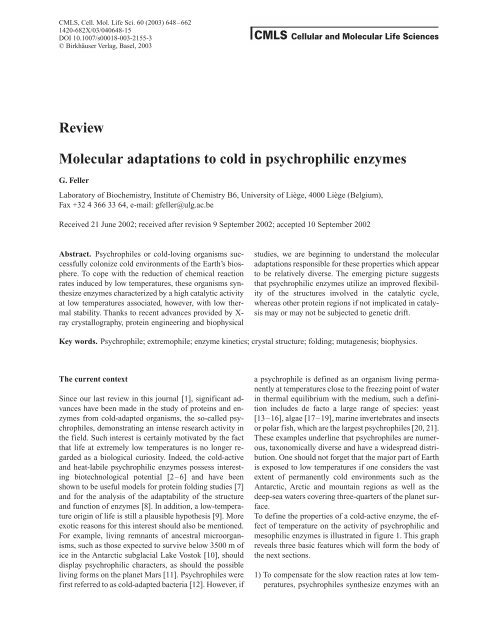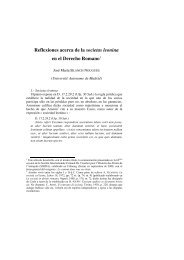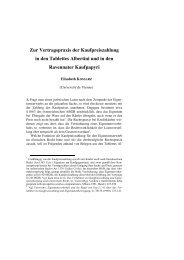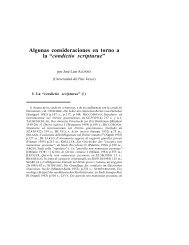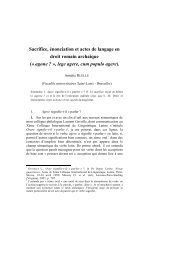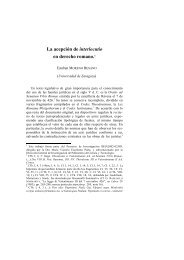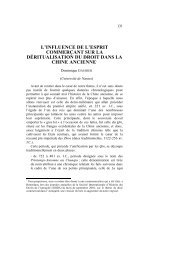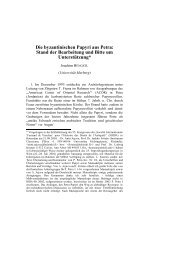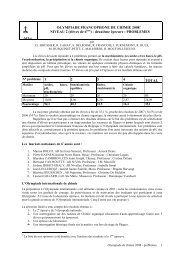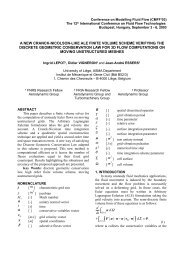Review Molecular adaptations to cold in psychrophilic enzymes
Review Molecular adaptations to cold in psychrophilic enzymes
Review Molecular adaptations to cold in psychrophilic enzymes
Create successful ePaper yourself
Turn your PDF publications into a flip-book with our unique Google optimized e-Paper software.
CMLS, Cell. Mol. Life Sci. 60 (2003) 648–6621420-682X/03/040648-15DOI 10.1007/s00018-003-2155-3© Birkhäuser Verlag, Basel, 2003CMLS Cellular and <strong>Molecular</strong> Life Sciences<strong>Review</strong><strong>Molecular</strong> <strong>adaptations</strong> <strong>to</strong> <strong>cold</strong> <strong>in</strong> <strong>psychrophilic</strong> <strong>enzymes</strong>G. FellerLabora<strong>to</strong>ry of Biochemistry, Institute of Chemistry B6, University of Liège, 4000 Liège (Belgium),Fax +32 4 366 33 64, e-mail: gfeller@ulg.ac.beReceived 21 June 2002; received after revision 9 September 2002; accepted 10 September 2002Abstract. Psychrophiles or <strong>cold</strong>-lov<strong>in</strong>g organisms successfullycolonize <strong>cold</strong> environments of the Earth’s biosphere.To cope with the reduction of chemical reactionrates <strong>in</strong>duced by low temperatures, these organisms synthesize<strong>enzymes</strong> characterized by a high catalytic activityat low temperatures associated, however, with low thermalstability. Thanks <strong>to</strong> recent advances provided by X-ray crystallography, prote<strong>in</strong> eng<strong>in</strong>eer<strong>in</strong>g and biophysicalstudies, we are beg<strong>in</strong>n<strong>in</strong>g <strong>to</strong> understand the molecular<strong>adaptations</strong> responsible for these properties which appear<strong>to</strong> be relatively diverse. The emerg<strong>in</strong>g picture suggeststhat <strong>psychrophilic</strong> <strong>enzymes</strong> utilize an improved flexibilityof the structures <strong>in</strong>volved <strong>in</strong> the catalytic cycle,whereas other prote<strong>in</strong> regions if not implicated <strong>in</strong> catalysismay or may not be subjected <strong>to</strong> genetic drift.Key words. Psychrophile; extremophile; enzyme k<strong>in</strong>etics; crystal structure; fold<strong>in</strong>g; mutagenesis; biophysics.The current contextS<strong>in</strong>ce our last review <strong>in</strong> this journal [1], significant advanceshave been made <strong>in</strong> the study of prote<strong>in</strong>s and <strong>enzymes</strong>from <strong>cold</strong>-adapted organisms, the so-called psychrophiles,demonstrat<strong>in</strong>g an <strong>in</strong>tense research activity <strong>in</strong>the field. Such <strong>in</strong>terest is certa<strong>in</strong>ly motivated by the factthat life at extremely low temperatures is no longer regardedas a biological curiosity. Indeed, the <strong>cold</strong>-activeand heat-labile <strong>psychrophilic</strong> <strong>enzymes</strong> possess <strong>in</strong>terest<strong>in</strong>gbiotechnological potential [2–6] and have beenshown <strong>to</strong> be useful models for prote<strong>in</strong> fold<strong>in</strong>g studies [7]and for the analysis of the adaptability of the structureand function of <strong>enzymes</strong> [8]. In addition, a low-temperatureorig<strong>in</strong> of life is still a plausible hypothesis [9]. Moreexotic reasons for this <strong>in</strong>terest should also be mentioned.For example, liv<strong>in</strong>g remnants of ancestral microorganisms,such as those expected <strong>to</strong> survive below 3500 m ofice <strong>in</strong> the Antarctic subglacial Lake Vos<strong>to</strong>k [10], shoulddisplay <strong>psychrophilic</strong> characters, as should the possibleliv<strong>in</strong>g forms on the planet Mars [11]. Psychrophiles werefirst referred <strong>to</strong> as <strong>cold</strong>-adapted bacteria [12]. However, ifa psychrophile is def<strong>in</strong>ed as an organism liv<strong>in</strong>g permanentlyat temperatures close <strong>to</strong> the freez<strong>in</strong>g po<strong>in</strong>t of water<strong>in</strong> thermal equilibrium with the medium, such a def<strong>in</strong>ition<strong>in</strong>cludes de fac<strong>to</strong> a large range of species: yeast[13–16], algae [17–19], mar<strong>in</strong>e <strong>in</strong>vertebrates and <strong>in</strong>sectsor polar fish, which are the largest psychrophiles [20, 21].These examples underl<strong>in</strong>e that psychrophiles are numerous,taxonomically diverse and have a widespread distribution.One should not forget that the major part of Earthis exposed <strong>to</strong> low temperatures if one considers the vastextent of permanently <strong>cold</strong> environments such as theAntarctic, Arctic and mounta<strong>in</strong> regions as well as thedeep-sea waters cover<strong>in</strong>g three-quarters of the planet surface.To def<strong>in</strong>e the properties of a <strong>cold</strong>-active enzyme, the effec<strong>to</strong>f temperature on the activity of <strong>psychrophilic</strong> andmesophilic <strong>enzymes</strong> is illustrated <strong>in</strong> figure 1. This graphreveals three basic features which will form the body ofthe next sections.1) To compensate for the slow reaction rates at low temperatures,psychrophiles synthesize <strong>enzymes</strong> with an
CMLS, Cell. Mol. Life Sci. Vol. 60, 2003 <strong>Review</strong> Article 649Figure 1. Effect of temperature on the activity of <strong>psychrophilic</strong> ()and mesophilic () <strong>enzymes</strong>. The thermodependence of the activity(of a-amylases <strong>in</strong> this case) illustrates the three ma<strong>in</strong> adaptive traitsof <strong>psychrophilic</strong> <strong>enzymes</strong>.up <strong>to</strong> tenfold higher specific activity <strong>in</strong> this temperaturerange. This is <strong>in</strong> fact the ma<strong>in</strong> physiological adaptation<strong>to</strong> <strong>cold</strong> at the enzyme level.2) The temperature for apparent maximal activity for<strong>cold</strong>-active <strong>enzymes</strong> is shifted <strong>to</strong>wards low temperatures,reflect<strong>in</strong>g the weak stability of these prote<strong>in</strong>swhich are prone <strong>to</strong> unfold<strong>in</strong>g and <strong>in</strong>activation at moderatetemperatures.3) F<strong>in</strong>ally, the adaptation <strong>to</strong> <strong>cold</strong> is frequently not perfect.Figure 1 illustrates that the specific activity of the <strong>psychrophilic</strong>enzyme at low temperatures, although veryhigh, rema<strong>in</strong>s generally lower than that of themesophilic <strong>enzymes</strong> at 37°C.Some reviews have been published recently by our group[22–26] but other excellent reviews should also be consultedfor a complete coverage of this <strong>to</strong>pic [4, 11,27–33].Recomb<strong>in</strong>ant <strong>psychrophilic</strong> <strong>enzymes</strong>A major achievement <strong>in</strong> the study of <strong>psychrophilic</strong> <strong>enzymes</strong>was the availability of recomb<strong>in</strong>ant <strong>enzymes</strong> thathave been produced <strong>in</strong> sufficient amount <strong>to</strong> determ<strong>in</strong>e X-ray structures and for their analysis by sophisticated biophysicalmethods. This has also opened the way for mutagenesisstudies. The first <strong>cold</strong>-active <strong>enzymes</strong> werecloned <strong>in</strong> Escherichia coli and selected by the activity ofthe gene product expressed by the recomb<strong>in</strong>ant colonies[34–36]. Later, the high level of sequence identity withmesophilic homologues demonstrated by <strong>psychrophilic</strong><strong>enzymes</strong> prompted the isolation by the polymerase cha<strong>in</strong>reaction of other genes that cannot be detected <strong>in</strong> expressionlibraries [37, 38]. Accord<strong>in</strong>gly, the study of rare <strong>enzymes</strong>was also made possible, such as the elongationfac<strong>to</strong>rs EF-2 [39–41] and Tu [42] or a DNA ligase [43]which only occurs as 200 molecules per cell, thereforepreclud<strong>in</strong>g its direct purification <strong>in</strong> reasonable amounts.The availability of these genes also allowed an explorationof the overexpression of these <strong>psychrophilic</strong> <strong>enzymes</strong><strong>in</strong> a mesophilic host. Various E. coli stra<strong>in</strong>s wereused for this purpose, whereas expression <strong>in</strong> Bacillusspecies [44, 45] or yeast was rarely addressed. The firstconcern of workers <strong>in</strong> the field was <strong>to</strong> establish if an enzymeexpressed near 0°C by the wild-type stra<strong>in</strong> ma<strong>in</strong>ta<strong>in</strong>sits properties when expressed and folded at highertemperatures that are lethal for the parent microorganisms.Indeed, when expressed at a sufficiently low temperature(15–18°C), a recomb<strong>in</strong>ant <strong>psychrophilic</strong> enzymeis undist<strong>in</strong>guishable from its wild-type parent moleculeas regards k<strong>in</strong>etic parameters, fold<strong>in</strong>g properties[46] and three-dimensional (3D) structure [47]. By contrast,at 37°C, recomb<strong>in</strong>ant <strong>psychrophilic</strong> <strong>enzymes</strong> arefrequently not expressed or are quickly <strong>in</strong>activated. In addition,when expressed at this temperature, the propertiesof the recomb<strong>in</strong>ant <strong>psychrophilic</strong> enzyme seem <strong>to</strong> be alteredas a result of misfold<strong>in</strong>g or the occurrence of an <strong>in</strong>activatedpopulation [46]. Aff<strong>in</strong>ity tags added <strong>in</strong> fusion <strong>to</strong>a recomb<strong>in</strong>ant <strong>psychrophilic</strong> enzyme for purification purposesare also a concern. A His-tagged phosphoglyceratek<strong>in</strong>ase (PGK) has <strong>in</strong>termediate k<strong>in</strong>etic properties betweenthe native <strong>psychrophilic</strong> PGK and yeast PGK, adifference possibly aris<strong>in</strong>g from the stabilization center<strong>in</strong>troduced by the aff<strong>in</strong>ity tag [48]. As a practical conclusion,it is therefore advisable <strong>to</strong> express recomb<strong>in</strong>ant <strong>psychrophilic</strong><strong>enzymes</strong> at the lowest possible temperature, <strong>to</strong>cleave and remove aff<strong>in</strong>ity tags, <strong>to</strong> perform an aff<strong>in</strong>itychroma<strong>to</strong>graphy step (remov<strong>in</strong>g the possible <strong>in</strong>activefraction) and <strong>to</strong> perform active-site titration <strong>to</strong> calculatethe k<strong>in</strong>etic parameters.Recently, a recomb<strong>in</strong>ant <strong>psychrophilic</strong> enzyme has beenexpressed <strong>in</strong> <strong>psychrophilic</strong> bacteria [49]. For this purpose,a broad host range expression vec<strong>to</strong>r was constructedus<strong>in</strong>g a <strong>cold</strong>-adapted replication element derivedfrom a multicopy cryptic plasmid of the Antarctic Gramnegativebacterium Pseudoalteromonas haloplanktis.This study demonstrated that production of recomb<strong>in</strong>antprote<strong>in</strong>s can be performed at low temperatures, reveal<strong>in</strong>ga new biotechnological potential for <strong>psychrophilic</strong>stra<strong>in</strong>s.Structural fac<strong>to</strong>rs related <strong>to</strong> activityat low temperatureTo date, four crystal structures of bacterial <strong>psychrophilic</strong><strong>enzymes</strong> have been solved by X-ray crystallography[50–53] as has the structure of three ser<strong>in</strong>e proteasesfrom <strong>cold</strong>-adapted fish [54–56]. Other structures shouldbecome available soon as crystals of three other <strong>cold</strong>-ac-
650 G. Feller Cold-active <strong>enzymes</strong>tive <strong>enzymes</strong> have been obta<strong>in</strong>ed [57–59]. Unfortunately,only four of these X-ray structures have been comparedwith mesophilic or thermophilic homologues and analyzed<strong>in</strong> detail with regards <strong>to</strong> the structural parametersrelated <strong>to</strong> <strong>cold</strong> activity. These <strong>in</strong>clude the bacterial a-amylase [47], citrate synthase [53], malate dehydrogenase[52] and the fish tryps<strong>in</strong> [54]. Nevertheless, this limitedset of data has already provided valuable <strong>in</strong>sights <strong>in</strong><strong>to</strong>the molecular basis of <strong>cold</strong> adaptation [30, 60–62]. As <strong>in</strong>ferredfrom their am<strong>in</strong>o acid sequences and homologymodels, <strong>psychrophilic</strong> <strong>enzymes</strong> do not display unusual orexotic conformations. On the contrary, the overall fold isvery close <strong>to</strong> that of their mesophilic homologues. For example,when the 3D structures of mammalian a-amylasesare superimposed on the <strong>psychrophilic</strong> a-amylase, theroot mean square deviation is only about 0.5 Å, reflect<strong>in</strong>ga high similarity of the tertiary structures [47].As far as the active site of <strong>psychrophilic</strong> <strong>enzymes</strong> is concerned,all reactive side cha<strong>in</strong>s as well as most side cha<strong>in</strong>spo<strong>in</strong>t<strong>in</strong>g <strong>to</strong>wards the catalytic cavity are strictly conserved.This means that the overall catalytic mechanismand reaction pathway are not modified <strong>in</strong> <strong>cold</strong>-active <strong>enzymes</strong>.This aspect is not really surpris<strong>in</strong>g as the specificreaction mechanism of <strong>enzymes</strong> is not prone <strong>to</strong> drasticvariation. However, worth mention<strong>in</strong>g is that all residuesform<strong>in</strong>g the active site can be conserved <strong>in</strong> a <strong>psychrophilic</strong>enzyme. This was demonstrated by the X-raystructure solved at high resolution of both the <strong>cold</strong>-activea-amylase and of its closest structural homologue frompig <strong>in</strong> complex with acarbose, a pseudosaccharide <strong>in</strong>hibi<strong>to</strong>rmimick<strong>in</strong>g the transition state <strong>in</strong>termediate [63,64]. Comparison of residues with direct or water-mediatedH bonds <strong>to</strong> the <strong>in</strong>hibi<strong>to</strong>r revealed that all 24 residues<strong>in</strong>volved are strictly conserved <strong>in</strong> the <strong>cold</strong>-active a-amylase.This outstand<strong>in</strong>g example of active-site identity (<strong>in</strong>terms of side cha<strong>in</strong> identity) demonstrates that the specificproperties of <strong>psychrophilic</strong> <strong>enzymes</strong> can be reachedwithout any am<strong>in</strong>o acid substitution <strong>in</strong> the reaction center.As a consequence, changes occurr<strong>in</strong>g elsewhere <strong>in</strong> themolecule are responsible for the optimization of the catalyticparameters of this enzyme, as demonstrated by sitedirectedmutagenesis [65], probably by modify<strong>in</strong>g the dynamicand conformational properties of the conservedresidues.Another important feature of the active site refers <strong>to</strong> itsaccessibility, because <strong>in</strong> many cases, the catalytic cavityappears <strong>to</strong> be larger and more accessible <strong>to</strong> ligands. Thislarger open<strong>in</strong>g of the catalytic cleft is achieved <strong>in</strong> variousways, <strong>in</strong>clud<strong>in</strong>g small deletions <strong>in</strong> loops border<strong>in</strong>g the activesite or by dist<strong>in</strong>ct conformation of these loops, and byreplacement of bulky side cha<strong>in</strong>s for smaller groups at theentrance. This aspect has been well illustrated for the<strong>cold</strong>-active citrate synthase [53]. The reasons for such abetter accessibility are still not clearly unders<strong>to</strong>od but<strong>cold</strong>-active <strong>enzymes</strong> are thought <strong>to</strong> accommodate substratesat lower energy cost, as far as the conformationalchanges are concerned, and therefore reduce the activationenergy required for the formation of the enzyme-substratecomplex. The larger active site may also facilitateeasier release and exit of products and thus may alleviatethe effect of a rate-limit<strong>in</strong>g step on the reaction rate. Thislarger size of the active site and the better accessibilityhave at least two consequences. First, non-specific <strong>enzymes</strong>accept<strong>in</strong>g various substrates should have a broaderspecificity, because substrates with slightly dist<strong>in</strong>ct conformationsor sizes can fit and b<strong>in</strong>d <strong>to</strong> the site. For example,the observed differences <strong>in</strong> substrate specificity betweenAtlantic salmon and mammalian elastases havebeen <strong>in</strong>terpreted <strong>in</strong> terms of a somewhat wider and deeperb<strong>in</strong>d<strong>in</strong>g pocket for the <strong>cold</strong>-adapted elastase [28]. Thebroad specificity of a <strong>psychrophilic</strong> alcohol dehydrogenase,oxidiz<strong>in</strong>g large bulky alcohols, was also assigned <strong>to</strong>a highly flexible active site [66]. As a second consequence,substrates should b<strong>in</strong>d less firmly <strong>in</strong> the b<strong>in</strong>d<strong>in</strong>gsite, if no po<strong>in</strong>t mutations have occurred, giv<strong>in</strong>g rise <strong>to</strong>higher K m values. This is certa<strong>in</strong>ly one of the structuralexplanations for the observation that numerous <strong>cold</strong>active<strong>enzymes</strong>, which are strongly homologous <strong>to</strong>mesophilic counterparts, have lower b<strong>in</strong>d<strong>in</strong>g constants.F<strong>in</strong>ally, differences <strong>in</strong> electrostatic potentials <strong>in</strong> andaround the active site of <strong>psychrophilic</strong> <strong>enzymes</strong> appear <strong>to</strong>be a crucial parameter for activity at low temperatures.Interest<strong>in</strong>gly, the <strong>cold</strong>-active citrate synthase [53], malatedehydrogenase [52] and tryps<strong>in</strong> [28, 67, 68] are characterizedby marked differences <strong>in</strong> electrostatic potentialsnear the active-site region when compared with mesophilicor thermophilic counterparts. In the case of malatedehydrogenase for example, the <strong>in</strong>creased positive potentialat and around the oxaloacetate-b<strong>in</strong>d<strong>in</strong>g site and thesignificantly decreased negative surface potential at theNADH-b<strong>in</strong>d<strong>in</strong>g region may facilitate the <strong>in</strong>teraction ofthe oppositely charged ligands with the surface of the enzyme.In all cases, the differences were caused by discretesubstitutions <strong>in</strong> non-conserved charged residues result<strong>in</strong>g<strong>in</strong> local electrostatic potential differ<strong>in</strong>g <strong>in</strong> both sign andmagnitude. Future work <strong>in</strong> the field will certa<strong>in</strong>ly ref<strong>in</strong>ethe structural and functional relationships between electrostaticpotentials and catalytic efficiency <strong>in</strong> <strong>psychrophilic</strong><strong>enzymes</strong>.Structural fac<strong>to</strong>rs l<strong>in</strong>ked <strong>to</strong> stabilityThe numerous homology-based models and especiallythe recently solved X-ray structures of <strong>psychrophilic</strong> <strong>enzymes</strong>have deciphered the molecular orig<strong>in</strong> of the weakstability characteriz<strong>in</strong>g these prote<strong>in</strong>s. All structural fac<strong>to</strong>rscurrently known <strong>to</strong> stabilize the prote<strong>in</strong> molecule canbe attenuated <strong>in</strong> strength and number <strong>in</strong> the structure of<strong>cold</strong>-active <strong>enzymes</strong> [28, 30, 62]. This <strong>in</strong>volves the clus-
CMLS, Cell. Mol. Life Sci. Vol. 60, 2003 <strong>Review</strong> Article 651ter<strong>in</strong>g of glyc<strong>in</strong>e residues (provid<strong>in</strong>g local mobility), thedisappearance of prol<strong>in</strong>e residues <strong>in</strong> loops (provid<strong>in</strong>g enhancedcha<strong>in</strong> flexibility between secondary structures), areduction <strong>in</strong> arg<strong>in</strong><strong>in</strong>e residues which are capable of form<strong>in</strong>gmultiple salt bridges and H bonds, as well as a lowernumber of ion pairs, aromatic <strong>in</strong>teractions or H bondscompared <strong>to</strong> mesophilic <strong>enzymes</strong>. The size and relativehydrophobicity of non-polar residue clusters form<strong>in</strong>g theprote<strong>in</strong> core are frequently smaller, lower<strong>in</strong>g the compactnessof the prote<strong>in</strong> <strong>in</strong>terior. The N and C caps of a-helices are also altered (weaken<strong>in</strong>g the charge-dipole <strong>in</strong>teraction)and loose or relaxed prote<strong>in</strong> extremities appear<strong>to</strong> be preferential sites for unzipp<strong>in</strong>g. The b<strong>in</strong>d<strong>in</strong>g of stabiliz<strong>in</strong>gions, such as calcium, can be extremely weak,with b<strong>in</strong>d<strong>in</strong>g constants differ<strong>in</strong>g from mesophiles by severalorders of magnitude. Insertions and deletions aresometimes responsible for specific properties such as theacquisition of extra surface charges (<strong>in</strong>sertion) or theweaken<strong>in</strong>g of subunit <strong>in</strong>teractions (deletion).Calculation of the solvent-accessible area showed thatsome <strong>psychrophilic</strong> <strong>enzymes</strong> expose a higher proportionof non-polar residues <strong>to</strong> the surround<strong>in</strong>g medium [47,53]. This is an entropy-driven destabiliz<strong>in</strong>g fac<strong>to</strong>r causedby the reorganization of water molecules around exposedhydrophobic side cha<strong>in</strong>s. Calculations of the electrostaticpotential revealed <strong>in</strong> some cases an excess of negativecharges at the surface of the molecule and, <strong>in</strong>deed, the pIof <strong>cold</strong>-active <strong>enzymes</strong> is frequently more acidic than tha<strong>to</strong>f their mesophilic or thermophilic homologues. This hasbeen related <strong>to</strong> improved <strong>in</strong>teractions with the solvent,which could be of prime importance <strong>in</strong> the acquisition offlexibility near zero degrees [69]. Besides the balance ofcharges, the number of salt bridges cover<strong>in</strong>g the prote<strong>in</strong>surface is also reduced. There is now a clear correlationbetween surface ion pairs and temperature adaptation,s<strong>in</strong>ce these weak <strong>in</strong>teractions significantly <strong>in</strong>crease <strong>in</strong>number from psychrophiles <strong>to</strong> mesophiles, thermophilesand hyperthermophiles, the latter show<strong>in</strong>g arg<strong>in</strong><strong>in</strong>e-mediatedmultiple ion pairs and <strong>in</strong>terconnected salt bridgenetworks [70, 71]. Such an altered pattern of electrostatic<strong>in</strong>teractions at the molecular surface is thought <strong>to</strong> improvethe resilience [72] or the ‘breath<strong>in</strong>g’ of the externalshell of <strong>cold</strong>-active <strong>enzymes</strong>.Of course, all these fac<strong>to</strong>rs are not found <strong>in</strong> every <strong>cold</strong>-activeenzyme: each enzyme adopts its own strategy by us<strong>in</strong>gone or a comb<strong>in</strong>ation of these altered structural fac<strong>to</strong>rs<strong>to</strong> improve the local or global mobility of the prote<strong>in</strong>edifice. An example is given <strong>in</strong> table 1 which provides asummary of the structural fac<strong>to</strong>rs possibly <strong>in</strong>volved <strong>in</strong> thelow stability of a <strong>psychrophilic</strong> a-amylase. A recent comparativestructural analysis of <strong>psychrophilic</strong>, mesophilicand thermophilic <strong>enzymes</strong> reports that each prote<strong>in</strong> familydisplays a different structural strategy <strong>to</strong> adapt <strong>to</strong> temperature.However, some common trends are observed:the number of ion pairs, the side cha<strong>in</strong> contribution <strong>to</strong> theTable 1. Structural parameters potentially <strong>in</strong>volved <strong>in</strong> the stabilityof a-amylase conformation as deduced from the X-ray structures[47, 63, 74]a-amylase Psychrophile MesophileProl<strong>in</strong>e content 13 21Salt bridges 18 26Arg<strong>in</strong><strong>in</strong>e content 13 28Arg-mediated salt bridges 8 17Arg-mediated am<strong>in</strong>o-aromatic 2 13<strong>in</strong>teractionsArg-mediated H bonds 20 42Disulfide bonds 4 5Core cluster hydrophobicity (S H i ) 47 103Non-constra<strong>in</strong>ed residues at 6 0C term<strong>in</strong>usAromatic-aromatic <strong>in</strong>teractions 19 20Am<strong>in</strong>o-aromatic <strong>in</strong>teractions 2 13Oxygen-aromatic <strong>in</strong>teractions 24 19Sulfur-aromatic <strong>in</strong>teractions 2 5a helix dipole – charges <strong>in</strong> Na 2 4+ charges <strong>in</strong> Ca 3 6Calcium-b<strong>in</strong>d<strong>in</strong>g constant (M –1 ) 5.0 ¥ 10 7 2.0 ¥ 10 11Chloride-b<strong>in</strong>d<strong>in</strong>g constant (M –1 ) 1.6 ¥ 10 2 3.5 ¥ 10 3Data for the <strong>psychrophilic</strong> a-amylase differ slightly from Aghajariet al. [47] as only one crystal form is considered and bond lengthlimits are different.exposed surface and the apolar fraction of the buried surfaceshow a consistent decrease with decreas<strong>in</strong>g optimaltemperatures [62].K<strong>in</strong>etic optimization of <strong>cold</strong>-active <strong>enzymes</strong>As mentioned, improv<strong>in</strong>g the turnover number k cat is thema<strong>in</strong> physiological adaptation, because it offsets the <strong>in</strong>hibi<strong>to</strong>ryeffect of low temperatures on reaction rates andtherefore provides adequate raw metabolic activity <strong>to</strong> thegrow<strong>in</strong>g organism. However, both k cat and K m are fundamentalk<strong>in</strong>etic parameters characteriz<strong>in</strong>g an enzymaticreaction and the specificity constant k cat /K m is generally abetter <strong>in</strong>dication of catalytic efficiency than k cat alone. Inpr<strong>in</strong>ciple, <strong>cold</strong>-adapted <strong>enzymes</strong> can optimize the k cat /K mratio by <strong>in</strong>creas<strong>in</strong>g k cat , decreas<strong>in</strong>g K m or by changes <strong>in</strong>both k cat and K m . Inspection of the available data, althoughlimited [for compilations see refs 4 and 28], reveals twoma<strong>in</strong> trends: <strong>cold</strong>-active <strong>enzymes</strong> that improve k cat at theexpense of K m (both k cat and K m <strong>in</strong>crease) and those improv<strong>in</strong>gthe k cat /K m ratio (<strong>in</strong>crease of k cat and decrease ofK m ). As will be discussed <strong>in</strong> the next sections, both k<strong>in</strong>eticbehaviors seem <strong>to</strong> be related <strong>to</strong> <strong>cold</strong>-active <strong>enzymes</strong> devoidof adaptive mutations with<strong>in</strong> the active site and <strong>to</strong><strong>enzymes</strong> display<strong>in</strong>g adaptive mutations with<strong>in</strong> the catalyticcenter, respectively.
652 G. Feller Cold-active <strong>enzymes</strong>Improv<strong>in</strong>g the turnover number k cat :a thermodynamic challengeThe catalytic constant k cat corresponds <strong>to</strong> the maximumnumber of substrate molecules converted <strong>to</strong> product peractive site per unit of time. In the simple Michaelis-Menten mechanism, the k cat parameter is the first-orderrate constant for the chemical conversion of the <strong>enzymes</strong>ubstratecomplex <strong>to</strong> enzyme and product. The transitionstate theory assumes the existence of a stable activatedcomplex ES # <strong>in</strong> equilibrium with the ground state ES:k catE + S ´ ES ´ ES# æÆ E + P (1)and the temperature dependence of the catalytic rate constantis given by the follow<strong>in</strong>g relation which is formallyequivalent <strong>to</strong> the Arrhenius law:k B Tk cat = k 7 e – DG# /RT(2)hwhere k is the transmission coefficient generally close <strong>to</strong>1, k B is the Bolzmann constant (1.3805 ¥ 10 –23 J K –1 ), hthe Planck constant (6.6256 ¥ 10 –34 J s) and DG # the freeenergy of activation or the variation of the Gibbs energybetween the activated enzyme-substrate complex ES # andES. The transition state theory conta<strong>in</strong>s several wellknownsimplifications and <strong>in</strong>terpretation of the absolutevalue of the thermodynamic parameters of activationshould be taken with caution. In the context of <strong>cold</strong>adaptation has come the proposal <strong>to</strong> compare the variationof the thermodynamic parameters [25] between <strong>psychrophilic</strong>( p ) and mesophilic ( m ) <strong>enzymes</strong>, namelyD(DG # ) p–m , D(DH # ) p–m and D(DS # ) p–m . Such parametersare compiled <strong>in</strong> table 2. It should be stressed that commonlyfound negative values provide useful <strong>in</strong>sights <strong>in</strong><strong>to</strong>the way <strong>psychrophilic</strong> <strong>enzymes</strong> have evolved.As <strong>in</strong>ferred from equation 2, the D(DG # ) p–m parametersimply reflects the fact that <strong>psychrophilic</strong> <strong>enzymes</strong> aremore active than their mesophilic homologues. However,the small value of this parameter orig<strong>in</strong>ates from largedifferences <strong>in</strong> the enthalpic and entropic contributions,D(DH # ) p–m and TD(DS # ) p–m , respectively, between <strong>cold</strong>adaptedand mesophilic <strong>enzymes</strong>. To appreciate the <strong>in</strong>formativecontent of D(DH # ) p–m , the exponential term ofequation 2 can be rewritten as:k B Tk cat = 7 e – (DH# /RT – DS # /R) (3)hIn this form, one can note that either a decrease of DH # oran <strong>in</strong>crease of DS # results <strong>in</strong> an <strong>in</strong>crease of k cat . However,the contribution of the DH # /RT term <strong>to</strong> the decrease of k catis larger when the temperature T is lowered. Interest<strong>in</strong>gly,all <strong>psychrophilic</strong> <strong>enzymes</strong> studied so far possess lowerTable 2. Activation parameters for the activity of <strong>psychrophilic</strong> and mesophilic <strong>enzymes</strong> [25].Enzyme Source T k cat DG # DH # TDS # D(DG # ) p-m D(DH # ) p-m TD(DS # ) p-m(°C) (s –1 ) (kJ/mol) (kJ/mol) (kJ/mol) (kJ/mol) (kJ/mol) (kJ/mol)Tryps<strong>in</strong> psychrophile Greenland cod 5 82.0 57.7 33.0 –24.5 –2.5 –20.9 –18.3mesophile bov<strong>in</strong>e 27.7 60.2 53.9 –6.2Tryps<strong>in</strong> psychrophile Antarctic cod 15 0.97 70.5 40.6 –29.9 –0.9 –42.0 –41.2mesophile bov<strong>in</strong>e 0.68 71.4 82.6 11.3Amylase psychrophile Alteromonas 15 495.2 55.6 73.6 18.0 –4.1 –26.0 –21.9mesophile Bacillus 90.5 59.7 99.6 39.9Subtilis<strong>in</strong> sychrophile Bacillus TA41 15 25.4 62.7 36 –26.7 –3.7 –10.0 –6.3mesophile B. subtillis 5.4 66.4 46 –20.4Glucose- psychrophile Antarctic fish 0 106.5 56.1 36.8 –19.3 –2.1 –15.1 –13.06-phosphate mesophile human 42.4 58.2 51.9 –6.3dehydrogenaseXylanase psychrophile Antarctic yeast 5 14.8 61.7 45.4 –16.3 –2.6 –4.5 –1.9mesophile yeast 4.9 64.3 49.9 –14.4Chi<strong>to</strong>biase psychrophile Arthrobacter 15 98.0 59.5 44.7 –14.8 –4.0 –26.8 –22.8mesophile S. marcescens 18.0 63.5 71.5 8.0Chit<strong>in</strong>ase A psychrophile Arthrobacter 15 1.7 69.2 60.2 –9.0 2.0 –14.1 –16.1mesophile S. marcescens 3.9 67.2 74.3 7.1Glutamate psychrophile Antarctic fish 5 3.8 64.8 33.4 –31.4 –3.3 –25.6 –22.3dehydrogenase mesophile bov<strong>in</strong>e 0.9 68.1 59.0 –9.1
CMLS, Cell. Mol. Life Sci. Vol. 60, 2003 <strong>Review</strong> Article 653DH # values (table 2) and therefore reduce the temperaturedependence of k cat and the <strong>in</strong>hibi<strong>to</strong>ry effect of low temperatureson enzyme reaction rates. Thus, the decrease ofthe activation enthalpy <strong>in</strong> the enzymatic reaction of <strong>psychrophilic</strong><strong>enzymes</strong> can be considered as the ma<strong>in</strong> adaptivecharacter <strong>to</strong> low temperatures. This decrease <strong>in</strong> activationenergy is achieved structurally by a decrease <strong>in</strong> thenumber of enthalpy-driven <strong>in</strong>teractions that have <strong>to</strong> bebroken dur<strong>in</strong>g the activation steps. These <strong>in</strong>teractions alsocontribute <strong>to</strong> the stability of the folded prote<strong>in</strong> conformationand, as a corollary, the structural doma<strong>in</strong> of the enzymebear<strong>in</strong>g the active site should be less stable. This isthe first <strong>in</strong>sight suggest<strong>in</strong>g that activity and stability arel<strong>in</strong>ked <strong>in</strong> the process of thermal adaptation. As far as theactivation entropy is concerned, the negative value ofD(DS # ) p–m can also be <strong>in</strong>terpreted assum<strong>in</strong>g a more resilientactive site from <strong>psychrophilic</strong> <strong>enzymes</strong> [25]. As aconsequence of active-site flexibility, the ground state enzyme-substratecomplex ES occupies a broader distributionof conformational states translated <strong>in</strong><strong>to</strong> <strong>in</strong>creased entropyof this state compared <strong>to</strong> that of the mesophilic homologues,lead<strong>in</strong>g <strong>to</strong> a negative value of D(DS # ) p–m .Adaptive drift and adaptive optimization of K mAs <strong>in</strong>ferred from the previous section, a broader distributionof the ground state ES should be accompanied by aweaker substrate b<strong>in</strong>d<strong>in</strong>g strength if <strong>in</strong>creases <strong>in</strong> k cat arereached through active-site resilience. In other words,there is an evolutionary pressure on K m <strong>to</strong> <strong>in</strong>crease <strong>in</strong> order<strong>to</strong> maximize the overall reaction rate [73]. If the substrateis weakly bound, the ground state ES complex willfall <strong>in</strong> a less deep energy pit and, as a consequence, the activationenergy of the reaction (DG # ) will be smaller, thatis k cat will be <strong>in</strong>creased (eq. 2). This is precisely what isfound <strong>in</strong> <strong>psychrophilic</strong> <strong>enzymes</strong> which display identicalsubstrate-b<strong>in</strong>d<strong>in</strong>g site and active-site architecture (<strong>in</strong>terms of side cha<strong>in</strong> identity) when compared with theirmesophilic homologues. This fundamental notion wasfirst <strong>in</strong>troduced <strong>in</strong> the study of fish lactate dehydrogenases(A 4 -LDHs). The active-site residues are fully conserved<strong>in</strong> A 4 -LDHs from South American and Antarcticno<strong>to</strong>thenoid fish, whereas the <strong>cold</strong>-adapted <strong>enzymes</strong> arecharacterized by higher k cat and K m constants. The conclusionwas that temperature-adaptive <strong>in</strong>creases <strong>in</strong> k cat occurconcomitantly with <strong>in</strong>creases <strong>in</strong> K m <strong>in</strong> <strong>cold</strong>-activeLDHs [73]. A second and even more conclusive exampleis given by the above-mentioned structures of <strong>cold</strong>-activeand porc<strong>in</strong>e a-amylases <strong>in</strong> complex with a large <strong>in</strong>hibi<strong>to</strong>r[63, 64]. Aga<strong>in</strong>, all am<strong>in</strong>o acids form<strong>in</strong>g the active site arestrictly conserved, although the <strong>cold</strong>-active enzyme possesseshigher k cat and K m . Worth mention<strong>in</strong>g is that this aspectseems <strong>to</strong> be valid for b<strong>in</strong>d<strong>in</strong>g constants for cofac<strong>to</strong>rs,allosteric effec<strong>to</strong>rs and ions [37, 42, 44, 74].Several <strong>enzymes</strong> counteract this adaptive drift of K m <strong>to</strong>ma<strong>in</strong>ta<strong>in</strong> or <strong>to</strong> improve the substrate-b<strong>in</strong>d<strong>in</strong>g aff<strong>in</strong>ity byam<strong>in</strong>o acid substitutions with<strong>in</strong> the active site. The firstreason for these <strong>enzymes</strong> <strong>to</strong> ‘react’ aga<strong>in</strong>st the drift is obviouswhen consider<strong>in</strong>g the regula<strong>to</strong>ry function associatedwith K m , especially for <strong>in</strong>tracellular <strong>enzymes</strong>. Thesecond reason is related <strong>to</strong> the temperature dependence ofweak <strong>in</strong>teractions. Substrate b<strong>in</strong>d<strong>in</strong>g is an especially temperature-sensitivestep because both the b<strong>in</strong>d<strong>in</strong>g geometryand <strong>in</strong>teractions between b<strong>in</strong>d<strong>in</strong>g site and ligand aregoverned by weak <strong>in</strong>teractions hav<strong>in</strong>g sometimes oppositetemperature dependencies. Hydrophobic <strong>in</strong>teractionsform endothermically and are weakened by a decrease <strong>in</strong>temperature. In contrast, <strong>in</strong>teractions of an electrostaticnature (ion pairs, hydrogen bonds, Van der Waals <strong>in</strong>teractions)form exothermically and are stabilized at low temperatures.Therefore, low temperatures not only <strong>in</strong>hibitthe enzyme activity (k cat ) but can also severely alter thesubstrate-b<strong>in</strong>d<strong>in</strong>g mode and strength accord<strong>in</strong>g <strong>to</strong> thetype of <strong>in</strong>teraction <strong>in</strong>volved.The chi<strong>to</strong>biase from Antarctic bacteria nicely illustratesboth aspects as well as the extent of the k<strong>in</strong>etic optimizationthat can be reached dur<strong>in</strong>g <strong>cold</strong> adaptation of <strong>enzymes</strong>[75]. As shown <strong>in</strong> figure 2, the k cat of the <strong>cold</strong>-activechi<strong>to</strong>biase is 8 times higher than that of a mesophilicchi<strong>to</strong>biase at 5°C. However, the K m for the substrate is 25times lower at this temperature and as a result, the k cat /K mfor the <strong>cold</strong>-active enzyme is nearly 200 times greater atlow temperature. In addition, the cross-shaped plot of K mshows that the K m of each enzyme tends <strong>to</strong> m<strong>in</strong>imal andoptimal values <strong>in</strong> the range of the correspond<strong>in</strong>g environmentaltemperatures, reflect<strong>in</strong>g the f<strong>in</strong>e tun<strong>in</strong>g of this parameterreached <strong>in</strong> the course of thermal adaptation. Inthe case of the mesophilic chi<strong>to</strong>biase, the 3D structure <strong>in</strong>dicatesthat two tryp<strong>to</strong>phan residues are the ma<strong>in</strong> substrate-b<strong>in</strong>d<strong>in</strong>gligands and perform hydrophobic <strong>in</strong>teractionswith the substrate. This can be related <strong>to</strong> thedecrease of K m with temperature, accord<strong>in</strong>g <strong>to</strong> the abovementionedthermal dependence of hydrophobic <strong>in</strong>teractions.Interest<strong>in</strong>gly, the two tryp<strong>to</strong>phan residues are notfound <strong>in</strong> the <strong>cold</strong>-active chi<strong>to</strong>biase but are replaced by polarresidues that are able <strong>to</strong> perform stronger <strong>in</strong>teractionsas the temperature decreases. Such replacements may expla<strong>in</strong>the cross-shaped plot, reveal<strong>in</strong>g a subtle adaptivestrategy that takes advantage of the thermodynamic propertiesof the bonds <strong>in</strong>volved <strong>in</strong> substrate b<strong>in</strong>d<strong>in</strong>g at lowtemperatures.A work<strong>in</strong>g hypothesisThe previous sections give the impression that two ma<strong>in</strong>types of adaptation occur <strong>in</strong> <strong>psychrophilic</strong> <strong>enzymes</strong>. Onthe one hand, <strong>enzymes</strong> that possess strictly identicalresidues <strong>in</strong> the active site as their mesophilic homo-
654 G. Feller Cold-active <strong>enzymes</strong>Figure 3. Correlation of the k<strong>in</strong>etic parameters <strong>in</strong> a <strong>psychrophilic</strong>enzyme (AHA), its stabilized mutants (closed circles) and amesophilic homologue (PPA). The general trend displayed by thestabilized mutants of AHA is <strong>to</strong> decrease both k cat and K m values[65].can counteract the adaptive drift of K m <strong>to</strong> meet other physiologicalrequirements.Mutational analysis of <strong>cold</strong>-activity determ<strong>in</strong>antsFigure 2. Temperature dependence of the k<strong>in</strong>etic parameters for<strong>psychrophilic</strong> () and mesophilic () chi<strong>to</strong>biases (from Arthrobactersp. and Serratia marcescens, respectively). Data for the catalyticrate constant k cat (a), the Michaelis parameter K m (b), note the differentscales used and the relative catalytic efficiency k cat /K m (psychrophile/mesophile)(c). The <strong>cold</strong>-adapted chi<strong>to</strong>biase is characterizedby a higher activity, an optimal K m value at low temperaturesand a 200-fold higher catalytic efficiency at 7°C [75].logues, possibly because the constra<strong>in</strong>ts imposed by thestructure and the enzyme function do not allow any adjustmentsat this level. On the other hand, some <strong>enzymes</strong>possess am<strong>in</strong>o acid replacements <strong>in</strong> the active site thatcan contribute <strong>to</strong> <strong>cold</strong> activity. Accord<strong>in</strong>g <strong>to</strong> the abovementionedenergetic aspects of enzyme-catalyzed reactionsat low temperature, a work<strong>in</strong>g hypothesis can be formulated.The high catalytic activity of <strong>psychrophilic</strong> <strong>enzymes</strong>corresponds <strong>to</strong> a decrease of DG # of the catalyzedreaction (eq. 2). For all <strong>cold</strong>-active <strong>enzymes</strong>, this decreaseof DG # is achieved by a decrease of DH # (table 2)that renders the catalyzed reaction less temperature sensitive,but requires a more flexible and therefore heat-labileactive site. As a result of this active site resilience, the entropiccontribution becomes larger and substrate b<strong>in</strong>d<strong>in</strong>gis weakened for <strong>enzymes</strong> devoid of adaptive mutations <strong>in</strong>the active site. This weak b<strong>in</strong>d<strong>in</strong>g also contributes <strong>to</strong> thedecrease <strong>in</strong> DG # as the ES complex falls <strong>in</strong> a less deep energypit. However, specific mutations <strong>in</strong> the active siteAn experimental demonstration of the relationships betweenk cat and K m was recently provided us<strong>in</strong>g <strong>psychrophilic</strong>and pig pancreatic a-amylases as models [65].Stabiliz<strong>in</strong>g weak <strong>in</strong>teractions found <strong>in</strong> the porc<strong>in</strong>e a-amylase, but absent <strong>in</strong> the <strong>cold</strong>-active a-amylase, wereeng<strong>in</strong>eered by site-directed mutagenesis <strong>in</strong> the <strong>psychrophilic</strong>enzyme at positions far from the catalytic center.As shown <strong>in</strong> figure 3, stabiliz<strong>in</strong>g and rigidify<strong>in</strong>g the<strong>cold</strong>-active a-amylase tends <strong>to</strong> decrease the k cat valuesand <strong>to</strong> decrease concomitantly the K m values of the mutant<strong>enzymes</strong>, reveal<strong>in</strong>g the high correlation betweenthese two k<strong>in</strong>etic parameters. This is also another strong<strong>in</strong>dication that structural flexibility is an essential featurerelated <strong>to</strong> catalysis at low temperatures <strong>in</strong> <strong>psychrophilic</strong><strong>enzymes</strong>. One should note that other mutational studiesof <strong>cold</strong>-active <strong>enzymes</strong> have been less conclusive. Citratesynthase [76], subtilis<strong>in</strong> [44], alkal<strong>in</strong>e phosphatase [77,78], ribonuclease [79] and chit<strong>in</strong>ase (unpublished results)have been eng<strong>in</strong>eered <strong>to</strong> check the <strong>in</strong>volvement of specificadaptive mutations with<strong>in</strong> or close <strong>to</strong> the active site.These studies have revealed a complex pattern of effectson k<strong>in</strong>etic parameters, activation energy and stability thatcannot be <strong>in</strong>terpreted <strong>in</strong> simple terms. Double mutantshave also demonstrated an unsuspected synergy between<strong>in</strong>dividual mutations sometimes giv<strong>in</strong>g rise <strong>to</strong> non-additiveor opposite effects. These <strong>in</strong>terest<strong>in</strong>g studies ma<strong>in</strong>lyhighlight our current <strong>in</strong>ability <strong>to</strong> predict the effect of s<strong>in</strong>gleside cha<strong>in</strong> replacement based on rational design of the
CMLS, Cell. Mol. Life Sci. Vol. 60, 2003 <strong>Review</strong> Article 655active site, not only <strong>in</strong> <strong>psychrophilic</strong> catalysts but <strong>in</strong> <strong>enzymes</strong><strong>in</strong> general. However, a s<strong>in</strong>gle mutation <strong>in</strong> the calcium-b<strong>in</strong>d<strong>in</strong>gsite of subtilis<strong>in</strong> [44] and <strong>in</strong> the phosphateb<strong>in</strong>d<strong>in</strong>ghelix of triose phosphate isomerase [51] wereshown <strong>to</strong> <strong>in</strong>crease drastically the thermostability of the<strong>psychrophilic</strong> mutants. These results underl<strong>in</strong>e the strong<strong>in</strong>volvement of bound cofac<strong>to</strong>rs <strong>in</strong> the modulation of stabilityand activity.Table 3. Thermodynamic parameters for the irreversible <strong>in</strong>activationat 52°C of Antarctic fish and bov<strong>in</strong>e L-glutamate dehydrogenases[80].Enzyme k i E a DG # DH # TDS #(m<strong>in</strong> –1) (kJ/mol) (kJ/mol) (kJ/mol) (kJ/mol)C. aceratus 0.230 659 94.9 657 562Ox 0.043 493 99.4 490 391Heat-labile activity and weak structural stabilityThe fast <strong>in</strong>activation of <strong>cold</strong>-active <strong>enzymes</strong> by temperaturehas been recognized for decades. As a rule, the halflifeof activity for most <strong>psychrophilic</strong> <strong>enzymes</strong> at50–60°C is about 10 m<strong>in</strong>, and a few hours at 37°C. However,some <strong>cold</strong>-active <strong>enzymes</strong> already denature at20–25°C. As it counteracts the <strong>in</strong>crease of activity withtemperature, this marked heat lability is responsible forthe shift of the apparent optimal temperature of activityshown <strong>in</strong> figure 1. The irreversible denaturation betweenthe native state N and the denatured <strong>in</strong>active state I can berepresented by a simple model characterized by a first-orderrate constant k i .k iN æÆ I (4)Surpris<strong>in</strong>gly, systematic analyses of this well-recognizedproperty are scarce and generally fragmental. Such ananalysis has been performed [80] for L-glutamate dehydrogenase(GDH) from the Antarctic fish Chaenocephalusaceratus (the white-blooded icefish) and for thebov<strong>in</strong>e enzyme (table 3). As anticipated, the activation energyDG # is lower for the fish enzyme, because it undergoesa faster denaturation. Because the <strong>cold</strong>-active GDHis <strong>in</strong>activated <strong>in</strong> a narrow temperature range, the slope ofthe Arrhenius plot is steep, lead<strong>in</strong>g <strong>to</strong> very high values ofboth E a and DH # and, by difference, <strong>to</strong> a high value ofTDS # . Therefore, the activity loss is entropically driven(the low DG # value arises from the unfavorable entropycontribution). At a given temperature, the activated stateof the <strong>psychrophilic</strong> enzyme is reached through a largerentropy variation, probably reflect<strong>in</strong>g an <strong>in</strong>creased localdisorder of the active site, which is the ma<strong>in</strong> driv<strong>in</strong>g forceof heat <strong>in</strong>activation. On the other hand, the larger enthalpyvariation accompany<strong>in</strong>g this process possibly reflectsthe higher cooperativity of heat <strong>in</strong>activation <strong>in</strong> the<strong>psychrophilic</strong> enzyme, orig<strong>in</strong>at<strong>in</strong>g from the lower numberof <strong>in</strong>teractions required <strong>to</strong> disrupt the active conformation.The orig<strong>in</strong> of the heat lability is obviously found <strong>in</strong> thelow stability of the structural elements form<strong>in</strong>g the activesite (localized flexibility) or <strong>in</strong> the weak conformationalstability of <strong>cold</strong>-active <strong>enzymes</strong> (global flexibility).Global and localized stability of <strong>enzymes</strong> may haveevolved <strong>in</strong>dependently [81]. Extr<strong>in</strong>sic stabilization bysolutes of lactate dehydrogenase from warm- and <strong>cold</strong>adaptedfish <strong>in</strong>dicates that the stability of the enzymemolecules is affected <strong>to</strong> the same extent whereas the k<strong>in</strong>eticparameters of <strong>cold</strong>-active lactate dehydrogenases ismore affected by cosolvents. This effect has been attributed<strong>to</strong> a flexible active site <strong>in</strong> <strong>cold</strong>-adapted <strong>enzymes</strong> thatcan be more compacted by preferential exclusion ofsolutes. Direct evidence of differences <strong>in</strong> stability betweenthe active site and the whole structure has beenprovided by microcalorimetric studies of multidoma<strong>in</strong>prote<strong>in</strong>s, as shown <strong>in</strong> figure 4. The <strong>cold</strong>-adapted chi<strong>to</strong>biasefrom the psychrophile Arthrobacter TAD 20 has amodular architecture consist<strong>in</strong>g of an active-site doma<strong>in</strong>,a galac<strong>to</strong>se-b<strong>in</strong>d<strong>in</strong>g doma<strong>in</strong> and an immunoglobul<strong>in</strong>-likedoma<strong>in</strong>, the latter two probably be<strong>in</strong>g <strong>in</strong>volved <strong>in</strong> theb<strong>in</strong>d<strong>in</strong>g on<strong>to</strong> the chit<strong>in</strong>ous exoskele<strong>to</strong>n of crustaceans.Differential scann<strong>in</strong>g calorimetry (DSC) thermograms ofthis <strong>cold</strong>-active chi<strong>to</strong>biase display both a heat-labile anda heat-stable doma<strong>in</strong> correspond<strong>in</strong>g <strong>to</strong> the catalytic doma<strong>in</strong>and <strong>to</strong> the b<strong>in</strong>d<strong>in</strong>g doma<strong>in</strong>s, respectively, as demonstratedby saccharide-b<strong>in</strong>d<strong>in</strong>g experiments [75]. The precursorof the <strong>psychrophilic</strong> a-amylase consists of the nativeenzyme and an extra doma<strong>in</strong> <strong>in</strong>volved <strong>in</strong> the bacterialsecretion [82]. The unfold<strong>in</strong>g profiles of the precursor(fig. 4b) also display a heat-labile and a heat-stable doma<strong>in</strong>correspond<strong>in</strong>g <strong>to</strong> the native enzyme and <strong>to</strong> the secretiondoma<strong>in</strong>, respectively. These unfold<strong>in</strong>g patternsclearly demonstrate that heat lability only affects thecalorimetric doma<strong>in</strong> conta<strong>in</strong><strong>in</strong>g the active site while leav<strong>in</strong>gstability of the non-catalytic doma<strong>in</strong>s less affected orunchanged. Thus heat lability is not simply the result ofthe lack of selective pressure for stable prote<strong>in</strong> <strong>in</strong> a <strong>cold</strong>environment (as demonstrated by the stable non-catalyticdoma<strong>in</strong>s) but seems <strong>to</strong> be the consequence of the improvedplasticity required around the active site for efficientactivity at low temperatures. Another stability patterndetected <strong>in</strong> a <strong>cold</strong>-active enzyme is also worth mention<strong>in</strong>g.The <strong>psychrophilic</strong> PGK from PseudomonasTACII 18 is a globular enzyme composed of two doma<strong>in</strong>sconnected by a h<strong>in</strong>ge region that bends dur<strong>in</strong>g catalysisform<strong>in</strong>g the active site at the <strong>in</strong>terface of the two doma<strong>in</strong>s.Surpris<strong>in</strong>gly, one doma<strong>in</strong> is heat labile whereas the seconddoma<strong>in</strong> has the same stability as mesophilic PGKs(fig. 4c). The heat-labile doma<strong>in</strong> may provide the re-
656 G. Feller Cold-active <strong>enzymes</strong>Figure 5. Thermal unfold<strong>in</strong>g of a-amylases recorded by DSC.When compared with the <strong>psychrophilic</strong> AHA (from P. haloplanktis),the heat-stable <strong>enzymes</strong> PPA (from pig pancreas) and BAA(from Bacillus amyloliquefaciens) are characterized by higher T m(<strong>to</strong>p of the transition) and DH cal (area under the transition) values,by a flatten<strong>in</strong>g of the transition and by the occurrence of calorimetricdoma<strong>in</strong>s <strong>in</strong>dicated by deconvolutions <strong>in</strong> th<strong>in</strong> l<strong>in</strong>es [65].Figure 4. Three examples of <strong>psychrophilic</strong> <strong>enzymes</strong> exhibit<strong>in</strong>g localflexibility. In chi<strong>to</strong>biase (a) and the a-amylase precursor (b), theactive site is embedded <strong>in</strong> the heat-labile doma<strong>in</strong>, whereas the stabilityof the non-catalytic doma<strong>in</strong>s is unaffected. In phosphoglyceratek<strong>in</strong>ase (c), the active site is formed at the <strong>in</strong>terface of both heatlabileand heat-stable doma<strong>in</strong>s by a h<strong>in</strong>ge-bend<strong>in</strong>g mechanism[48, 75].quired flexibility around the active site and favor the reactionrate, whereas the heat-stable doma<strong>in</strong> could improvesubstrate b<strong>in</strong>d<strong>in</strong>g (as <strong>in</strong>dicated by low K m values) asa result of its rigidity [48].Conformational stability of <strong>psychrophilic</strong> <strong>enzymes</strong>As a result of their weak stability, <strong>psychrophilic</strong> <strong>enzymes</strong>are valuable model compounds for fold<strong>in</strong>g studies and areconsequently <strong>in</strong>creas<strong>in</strong>gly <strong>in</strong>vestigated by more sophisticatedtechniques. Among these, DSC offers a def<strong>in</strong>itiveadvantage because several thermodynamic parametersrelated <strong>to</strong> prote<strong>in</strong> stability are recorded directly and notextrapolated from <strong>in</strong>direct data. Figure 5 displays thecalorimetric records, or thermograms, of heat-<strong>in</strong>ducedunfold<strong>in</strong>g for <strong>psychrophilic</strong>, mesophilic and heat-stablea-amylases. Several <strong>in</strong>terest<strong>in</strong>g observations can alreadybe made from these records.1) The unfold<strong>in</strong>g of the <strong>cold</strong>-adapted enzyme occurs atlower temperatures as <strong>in</strong>dicated by the T m values whichcorrespond <strong>to</strong> the temperature of half-denaturation(for a two-state process) and are given by the <strong>to</strong>p of thetransition.2) Prote<strong>in</strong> unfold<strong>in</strong>g is an endothermic process. The areaunder the curves (fig. 5) provides the <strong>to</strong>tal amount ofheat absorbed dur<strong>in</strong>g unfold<strong>in</strong>g and is given by thecalorimetric enthalpy, DH cal . This parameter corresponds<strong>to</strong> all enthalpic contributions <strong>in</strong>volved <strong>in</strong> ma<strong>in</strong>ta<strong>in</strong><strong>in</strong>gthe compact structure and is markedly lowerfor the <strong>psychrophilic</strong> enzyme. In addition, there is aclear trend for <strong>in</strong>creas<strong>in</strong>g DH cal values <strong>in</strong> the order psychrophile< mesophile < thermophile.3) The transition for the <strong>psychrophilic</strong> enzyme is sharpand symmetric whereas other <strong>enzymes</strong> are characterizedby a flatten<strong>in</strong>g of the thermograms. This is <strong>in</strong>dicativeof a pronounced cooperativity dur<strong>in</strong>g unfold<strong>in</strong>gof the <strong>psychrophilic</strong> enzyme: its structure is stabilizedby fewer weak <strong>in</strong>teractions and disruption ofsome of these <strong>in</strong>teractions strongly <strong>in</strong>fluences the entiremolecular edifice and promotes its unfold<strong>in</strong>g.4) The <strong>psychrophilic</strong> enzyme unfolds accord<strong>in</strong>g <strong>to</strong> an allor-noneprocess, reveal<strong>in</strong>g a uniformly low stability ofits architecture. By contrast, all other homologous <strong>enzymes</strong>display two <strong>to</strong> three transitions (either observableor <strong>in</strong>dicated by deconvolution of the heat capacityfunction <strong>in</strong> fig. 5). Therefore, the conformation ofthese mesophilic and thermophilic <strong>enzymes</strong> conta<strong>in</strong>sstructural blocks or units of dist<strong>in</strong>ct stability that unfold<strong>in</strong>dependently.
CMLS, Cell. Mol. Life Sci. Vol. 60, 2003 <strong>Review</strong> Article 6575) Although not illustrated by figure 5, the unfold<strong>in</strong>g ofthe <strong>psychrophilic</strong> enzyme is freely reversible whereasall other homologous <strong>enzymes</strong> are irreversibly unfoldedafter a DSC experiment. The weak hydrophobicityof the core clusters <strong>in</strong> the <strong>cold</strong>-adapted enzymeand the low melt<strong>in</strong>g temperature, at which hydrophobic<strong>in</strong>teractions are restra<strong>in</strong>ed, certa<strong>in</strong>ly account forthis reversible character because, unlike mesophilic a-amylases, aggregation does not occur.From this microcalorimetric study, one can conclude thatthe <strong>psychrophilic</strong> enzyme <strong>in</strong>vestigated possesses a fragilemolecular edifice that is uniformly unstable and stabilizedby fewer weak <strong>in</strong>teractions than homologous mesophilic orthermophilic prote<strong>in</strong>s [65, 69]. The contribution of <strong>in</strong>dividualweak <strong>in</strong>teraction <strong>to</strong> the above-mentioned behaviorwas analyzed by site-directed mutagenesis of the <strong>psychrophilic</strong>a-amylase [65]. Fourteen mutants of this enzymewere constructed, each bear<strong>in</strong>g an eng<strong>in</strong>eeredresidue form<strong>in</strong>g a weak <strong>in</strong>teraction found <strong>in</strong> mesophilic a-amylases but absent <strong>in</strong> the <strong>cold</strong>-active a-amylase. S<strong>in</strong>gleam<strong>in</strong>o acid side cha<strong>in</strong> substitutions were found <strong>to</strong> significantlymodify the melt<strong>in</strong>g po<strong>in</strong>t T m , the calorimetric enthalpyDH cal , the cooperativity and reversibility of unfold<strong>in</strong>gbut also the thermal <strong>in</strong>activation rate constant k i and thek<strong>in</strong>etic parameters k cat and K m . Thus, a fasc<strong>in</strong>at<strong>in</strong>g aspect ofthis study was the ability <strong>to</strong> dissect the contribution of <strong>in</strong>dividualam<strong>in</strong>o acid side cha<strong>in</strong>s <strong>to</strong> the structural propertiesof heat-labile and heat-stable prote<strong>in</strong>s.Thermodynamic stability of <strong>psychrophilic</strong> <strong>enzymes</strong>The reversible unfold<strong>in</strong>g pathway of some prote<strong>in</strong>s betweenthe native state N and the unfolded state U is characterizedby an equilibrium constant K.KN ¨Æ U (4)The free energy of conformation or free energy of unfold<strong>in</strong>gis therefore:DG N–U = – RT lnK= DH N–U – TDS N–U(6)The latter relation can be rewritten for any temperature(T) us<strong>in</strong>g the parameters determ<strong>in</strong>ed experimentally byDSC:DG N–U (T) = DH cal (1–T/T m ) + DCp(T–T m )– TDCp ln (T/T m ) (7)where DCp is the difference <strong>in</strong> heat capacity between thenative and the unfolded state. This parameter reflects thehydration of non-polar groups that are exposed <strong>to</strong> waterupon unfold<strong>in</strong>g and is determ<strong>in</strong>ed by another set ofcalorimetric experiments [83].Figure 6. Gibbs free energy of unfold<strong>in</strong>g or conformational stability.Stability curves for a <strong>psychrophilic</strong> a-amylase (heavy l<strong>in</strong>e), severalmesophilic prote<strong>in</strong>s (cont<strong>in</strong>uous l<strong>in</strong>es) and a thermophilic prote<strong>in</strong>(dashed l<strong>in</strong>e). To compare prote<strong>in</strong>s of various sizes, the free energyis expressed <strong>in</strong> specific units per mole of residue [69].The stability curves, i.e. the Gibbs free energy of unfold<strong>in</strong>gas a function of temperature, for <strong>psychrophilic</strong>,mesophilic and thermophilic prote<strong>in</strong>s are drawn <strong>in</strong> figure6. These curves correspond <strong>to</strong> the energy required <strong>to</strong> disruptthe prote<strong>in</strong> structure at any given temperature. This isa parabolic function limited by the temperature of <strong>cold</strong> denaturationT m’ (below 0°C, not shown) and by the high temperaturemelt<strong>in</strong>g po<strong>in</strong>t T m , at which by def<strong>in</strong>ition DG N–U =0 [84]. Aga<strong>in</strong>, these curves provide valuable <strong>in</strong>sights <strong>in</strong><strong>to</strong>the molecular <strong>adaptations</strong> of <strong>psychrophilic</strong> <strong>enzymes</strong>.1) In pr<strong>in</strong>ciple, the low stability of a prote<strong>in</strong> can bereached via three ways (or their comb<strong>in</strong>ation): by shift<strong>in</strong>gthe stability curve <strong>to</strong>ward low temperatures (with asimilar maximal value of DG N–U as mesophiles but atmuch lower temperatures), by <strong>in</strong>creas<strong>in</strong>g the steepnessof the stability curve (with a similar maximal value ofDG N–U as mesophiles, at the same temperature but witha lower T m ) or by a global collapse of the stabilitycurve. Each of these alternatives corresponds <strong>to</strong> acomb<strong>in</strong>ation of alterations <strong>in</strong> the DH cal , T m or DCp values<strong>in</strong> equation 7. Obviously, the stability curve of the<strong>cold</strong>-active a-amylase follows the third alternative: thestrik<strong>in</strong>gly weak conformational energy (DG N–U max =22 cal/mol of residue or 92 J/mol of residue for 453am<strong>in</strong>o acids) over the entire temperature range wherethe native state prevails, i.e. between both melt<strong>in</strong>gpo<strong>in</strong>ts, arises from low values of both DH cal and T m ,whereas DCp is not significantly affected.2) The temperature for maximal prote<strong>in</strong> stability does notusually correspond <strong>to</strong> the environmental temperatureof psychrophiles, mesophiles or thermophiles but is,rather, close <strong>to</strong> room temperature [7]. The temperatureexperienced by mesophiles and thermophiles lies onthe right side of the bell-shaped stability curve, pro-
658 G. Feller Cold-active <strong>enzymes</strong>vid<strong>in</strong>g evidence that their <strong>enzymes</strong> reach the necessarybalance between optimal stability (lead<strong>in</strong>g <strong>to</strong> a compactmolecule) and flexibility (required for the catalyticfunction) by us<strong>in</strong>g the thermal dissipative force,responsible for unfold<strong>in</strong>g at higher temperatures. Incontrast, the environmental temperatures, around 0°C,that are encountered by psychrophiles are found far onthe left side of the stability curve. Mention needs <strong>to</strong> bemade at this po<strong>in</strong>t that the decrease <strong>in</strong> stability with<strong>in</strong>this region of the curve shown <strong>in</strong> figure 6, and ultimatelylead<strong>in</strong>g <strong>to</strong> <strong>cold</strong> denaturation, arises from thehydration of prote<strong>in</strong> groups which destabilizes the prote<strong>in</strong>at decreas<strong>in</strong>g temperature [85]. It follows that theorig<strong>in</strong> of flexibility of <strong>psychrophilic</strong> <strong>enzymes</strong> at lowtemperatures <strong>in</strong>volves ma<strong>in</strong>ly group hydration, and istherefore drastically different from mesophilic andthermophilic prote<strong>in</strong>s, the latter tak<strong>in</strong>g advantage ofthe conformational entropy rise with temperature <strong>to</strong>ga<strong>in</strong> mobility. The improved <strong>in</strong>teractions with the solventsuggested by the crystal structure of some <strong>cold</strong>active<strong>enzymes</strong> re<strong>in</strong>force the idea that group hydrationplays an essential role <strong>in</strong> the acquisition of flexibility<strong>in</strong> <strong>psychrophilic</strong> prote<strong>in</strong>s.3) A surpris<strong>in</strong>g consequence of the free energy functionfor the <strong>psychrophilic</strong> a-amylase shown <strong>in</strong> figure 6 isits weak stability at low temperatures when comparedwith mesophilic and thermophilic prote<strong>in</strong>s, whereas<strong>in</strong>tuitively, <strong>cold</strong>-active prote<strong>in</strong>s were also expected <strong>to</strong>be <strong>cold</strong> stable. This prote<strong>in</strong> is <strong>in</strong> fact both heat and <strong>cold</strong>labile. Assum<strong>in</strong>g constant properties of the solvent below0°C (i.e. no freez<strong>in</strong>g) and the absence of protectiveeffects from cellular components, this a-amylaseshould unfold at –10°C. Incidentally, this temperatureclosely corresponds <strong>to</strong> the probable lower limit of bacterialgrowth and, therefore, <strong>cold</strong> denaturation of somekey <strong>enzymes</strong> <strong>in</strong> psychrophiles is an additional, thoughunsuspected fac<strong>to</strong>r fix<strong>in</strong>g the lower limit of life at lowtemperatures.4) The <strong>psychrophilic</strong> a-amylase has reached a state close<strong>to</strong> the lowest possible stability of the native state [65,69]. This fact <strong>in</strong>dicates that the <strong>cold</strong>-active a-amylasecould not be any less stable than it is. If <strong>psychrophilic</strong><strong>enzymes</strong> have <strong>in</strong>deed ga<strong>in</strong>ed <strong>in</strong> flexibility at the expenseof stability <strong>in</strong> the course of evolution, this impliesthat the actual native state precludes further adaptation<strong>to</strong>ward a more mobile structure. This aspect accountsfor the imperfect adaptation of the catalyticfunction <strong>in</strong> <strong>psychrophilic</strong> <strong>enzymes</strong>, mentioned at thebeg<strong>in</strong>n<strong>in</strong>g of this review and illustrated <strong>in</strong> figure 1.Natural versus directed evolutionDirected evolution has contributed significantly <strong>to</strong> explorethe role of multiple and dispersed substitutions thatact synergistically <strong>to</strong> modify enzyme properties and functions[86, 87]. Basically, random mutations are <strong>in</strong>troduced<strong>in</strong> a gene and the result<strong>in</strong>g library is screened forthe acquisition or improvement of a specific property.This approach reveals mutations responsible for immediateand drastic adaptation <strong>in</strong> response <strong>to</strong> a strong selectionimposed <strong>in</strong> the labora<strong>to</strong>ry and selected by a physicochemicalproperty. In contrast, natural evolution is a veryslow process driven by complex environmental and metabolicconstra<strong>in</strong>ts, and selected by the viability or performanceof a liv<strong>in</strong>g organism. What can we learn from theresults of labora<strong>to</strong>ry evolution and from the general traitsof <strong>psychrophilic</strong> <strong>enzymes</strong>?Labora<strong>to</strong>ry evolution has demonstrated that enzyme activityand stability are not physically l<strong>in</strong>ked <strong>in</strong> prote<strong>in</strong>s aspreviously thought, giv<strong>in</strong>g rise <strong>to</strong> the proposal that thelow stability of <strong>cold</strong>-active <strong>enzymes</strong> results from geneticdrift orig<strong>in</strong>at<strong>in</strong>g from the lack of selective pressure forstable prote<strong>in</strong>s [8]. However, mutations that simultaneously<strong>in</strong>crease activity and stability are very rare [88] andproved <strong>to</strong> be extremely complex <strong>to</strong> obta<strong>in</strong> [89]. In fact, <strong>in</strong>nature, these environmental constra<strong>in</strong>ts do not exist exceptfor thermophilic <strong>enzymes</strong> that catalyze the conversionof labile metabolic <strong>in</strong>termediates. As a matter of fact,phosphoribosyl anthranilate isomerase from Thermo<strong>to</strong>gamaritima was found <strong>to</strong> be both extremely stable and active[90]. When random mutants are only screened forhigh activity at low temperature dur<strong>in</strong>g directed evolution,the selected <strong>enzymes</strong> <strong>in</strong>variably display the canonicalproperties of <strong>psychrophilic</strong> <strong>enzymes</strong> [91–96]. Thiscan be unders<strong>to</strong>od from the above-mentioned results, asimprovement of activity at low temperatures associatedwith lost of stability appears <strong>to</strong> be the most frequent andaccessible strategy at the level of the prote<strong>in</strong> molecule.An elegant demonstration of this aspect was given us<strong>in</strong>gornith<strong>in</strong>e carbamoyltransferase from Pyrococcus furiosusbecause random mutagenesis was associated with a functionalscreen<strong>in</strong>g procedure <strong>in</strong>volv<strong>in</strong>g the survival of thehost stra<strong>in</strong> [94]. Consequently, the low stability of <strong>cold</strong>active<strong>enzymes</strong> may be the simplest way <strong>to</strong> acquire activity<strong>in</strong> the absence of selection for stable prote<strong>in</strong>s. Thus,the occurrence of heat-stable <strong>psychrophilic</strong> <strong>enzymes</strong>should not be ruled out.ConclusionsThe most widely accepted hypothesis account<strong>in</strong>g for thedom<strong>in</strong>ant adaptive traits of <strong>cold</strong>-active <strong>enzymes</strong>, i.e. thehigh activity and the weak stability, suggests that there is acorrelation between the activity, the flexibility and the stabilityof the enzyme molecule. The flexible structure of<strong>psychrophilic</strong> <strong>enzymes</strong> can provide enhanced ability <strong>to</strong> undergodiscrete and fast conformational changes at low temperaturesimposed by the catalytic events. But the price <strong>to</strong>
CMLS, Cell. Mol. Life Sci. Vol. 60, 2003 <strong>Review</strong> Article 659pay for such plasticity is, of course, the low stability of thenative enzyme structure [1]. This l<strong>in</strong>k between activity,flexibility and stability, although <strong>in</strong>tuitively satisfy<strong>in</strong>g, rema<strong>in</strong>s<strong>to</strong> be proven experimentally <strong>in</strong> <strong>cold</strong>-active <strong>enzymes</strong>.Nonetheless, these relationships have found strong experimentalsupport from the comparison of thermophilic andmesophilic <strong>enzymes</strong> [97–99]. In contrasts, very few attemptshave been made <strong>to</strong> quantify and compare the expectedflexibility of <strong>cold</strong>-adapted prote<strong>in</strong>s. The rate of hydrogen/deuteriumexchange was recorded by Fourier transform<strong>in</strong>frared spectroscopy for two <strong>cold</strong>-active <strong>enzymes</strong>[32, 100] but no significant exchange rate was foundbetween <strong>psychrophilic</strong> <strong>enzymes</strong> compared with themesophilic homologues. The nature of the prote<strong>in</strong> motion<strong>in</strong>volved <strong>in</strong> temperature adaptation is complex and rema<strong>in</strong>slargely hypothetical [101]. For example, amide hydrogenexchange experiments us<strong>in</strong>g rubredox<strong>in</strong> from P. furiosus,the most thermostable prote<strong>in</strong> presently known, <strong>in</strong>dicatethat conformational fluctuations for solvent access do notdiffer from those of mesophilic homologues at the millisecondtime scale [102], therefore question<strong>in</strong>g the <strong>in</strong>volvemen<strong>to</strong>f conformational rigidity <strong>in</strong> the extreme heatstability of this prote<strong>in</strong>. Incidentally, this unexpected resultalso raises some doubts about the connection between exchangerates and conformational flexibility. Directed evolutionsuggests that low stability results from genetic driftbut, <strong>in</strong> contrast, the biophysical studies mentioned <strong>in</strong> thisreview <strong>in</strong>dicate that flexibility is an <strong>in</strong>tegral component ofthe adaptive strategy. At this stage, the emerg<strong>in</strong>g picturesuggests that <strong>psychrophilic</strong> <strong>enzymes</strong> utilize an improvedflexibility of the structures <strong>in</strong>volved <strong>in</strong> the catalytic cycle(as <strong>in</strong>dicated by the common heat-labile activity), whereasother prote<strong>in</strong> regions, if not implicated <strong>in</strong> catalysis, may ormay not be subjected <strong>to</strong> genetic drift, as nicely illustratedby the <strong>cold</strong>-active chi<strong>to</strong>biase and the a-amylase precursor(fig. 4). A better understand<strong>in</strong>g of enzyme evolution andprote<strong>in</strong> dynamics is obviously the next challenge for biochemicalstudies of extremophiles.Acknowledgements. The author acknowledges with thanks thef<strong>in</strong>ancial support of the European Union, the Région wallonne,Belgium and the Fonds National de la Recherche Scientifique,Belgium. The support of the Institut Français de Recherche et deTechnologie Polaire has also been highly appreciated.1 Feller G. and Gerday C. (1997) Psychrophilic <strong>enzymes</strong>: molecularbasis of <strong>cold</strong> adaptation. Cell. Mol. Life Sci. 53: 830–8412 Gerday C., Aittaleb M., Bentahier M., Chessa J. P., Claverie P.,Coll<strong>in</strong>s T. et al. (2000) Cold-adapted <strong>enzymes</strong>: from fundamentals<strong>to</strong> biotechnology. Trends Biotechnol. 18: 103–1073 Marges<strong>in</strong> R. and Sch<strong>in</strong>ner F. (1999) Biotechnological Applicationsof Cold-Adapted Organisms, Spr<strong>in</strong>ger, Heidelberg4 Cavicchioli R., Siddiqui K. S., Andrews D. and Sowers K. R.(2002) Low-temperature extremophiles and their applications.Curr. Op<strong>in</strong>. Biotechnol. 13: 253–2615 Russell N. J. (1998) <strong>Molecular</strong> <strong>adaptations</strong> <strong>in</strong> <strong>psychrophilic</strong>bacteria: potential for biotechnological applications. Adv.Biochem. Eng. Biotechnol. 61: 1–216 Allen D., Hus<strong>to</strong>n A. L., Weels L. E. and Dem<strong>in</strong>g J. W. (2001)Biotechnological use of psychrophiles. In: Encyclopedia ofEnvironmental Microbiology, pp. 1–17, Bit<strong>to</strong>n G. (ed.),Wiley, New York7 Kumar S., Tsai C. J. and Nuss<strong>in</strong>ov R. (2002) Maximal stabilitiesof reversible two-state prote<strong>in</strong>s. Biochemistry 41:5359–53748 W<strong>in</strong>trode P. L. and Arnold F. H. (2000) Temperature adaptationof <strong>enzymes</strong>: lessons from labora<strong>to</strong>ry evolution. Adv. Prote<strong>in</strong>Chem. 55: 161–2259 Levy M. and Miller S. L. (1998) The stability of the RNAbases: implications for the orig<strong>in</strong> of life. Proc. Natl. Acad. Sci.USA 95: 7933–793810 Price P. B. (2000) A habitat for psychrophiles <strong>in</strong> deep Antarcticice. Proc. Natl. Acad. Sci. USA 97: 1247–125111 Dem<strong>in</strong>g J. W. (2002) Psychrophiles and polar regions. Curr.Op<strong>in</strong>. Microbiol. 5: 301–30912 Morita R. Y. (1975) Psychrophilic bacteria. Bacteriol. Rev. 39:144–16713 Sabri A., Bare G., Jacques P., Jabrane A., Ongena M., VanHeugen J. C. et al. (2001) Influence of moderate temperatureson myris<strong>to</strong>yl-CoA metabolism and acyl-CoA thioesterase activity<strong>in</strong> the <strong>psychrophilic</strong> Antarctic yeast Rhodo<strong>to</strong>rula aurantiaca.J. Biol. Chem. 276: 12691–1269614 Petrescu I., Lamotte-Brasseur J., Chessa J. P., Ntarima P.,Claeyssens M., Devreese B. et al. (2000) Xylanase from the<strong>psychrophilic</strong> yeast Cryp<strong>to</strong>coccus adeliae. Extremophiles 4:137–14415 Gomes J., Gomes I. and Ste<strong>in</strong>er W. (2000) Thermolabile xylanaseof the Antarctic yeast Cryp<strong>to</strong>coccus adeliae: productionand properties. Extremophiles 4: 227–23516 Deegenaars M. L. and Watson K. (1998) Heat shock response<strong>in</strong> <strong>psychrophilic</strong> and psychrotrophic yeast from Antarctica.Extremophiles 2: 41–4917 Devos N., Ingouff M., Loppes R. and Matagne R. F. (1998)Rubisco adaptation <strong>to</strong> low temperatures: a comparative study<strong>in</strong> <strong>psychrophilic</strong> and mesophilic unicellular algae. J. Phycol.34: 655–66018 Loppes R., Devos N., Willem S., Bartelemy P. and MatagneR. F. (1996) Effect of temperature on two <strong>enzymes</strong> from a<strong>psychrophilic</strong> Chloromonas (chlorophyta). J. Phycol. 32:276–27819 Willem S., Srahna M., Devos N., Gerday C., Loppes R. andMatagne R. F. (1999) Prote<strong>in</strong> adaptation <strong>to</strong> low temperatures:a comparative study of alpha-tubul<strong>in</strong> sequences <strong>in</strong> mesophilicand <strong>psychrophilic</strong> algae. Extremophiles 3: 221–22620 Prisco G. di, Pisano E. and Clarke A. (1998) Fishes of Antarctica:A Biological Overview, Spr<strong>in</strong>ger, Milan21 Eastman J. T. (1993) Antarctic Fish Biology: Evolution <strong>in</strong> aUnique Environment, Academic Press, San Diego22 D’Amico S., Claverie P., Coll<strong>in</strong>s T., Georlette D., Gratia E.,Hoyoux A. et al. (2002) <strong>Molecular</strong> basis of <strong>cold</strong> adaptation.Phil. Trans. R. Soc. Lond. B 357: 917–92523 D’Amico S., Claverie P., Coll<strong>in</strong>s T., Feller G., Georlette D.,Gratia E. et al. (2001) Cold-adapted <strong>enzymes</strong>: an unachievedsymphony. In: Prote<strong>in</strong> Adaptations and Signal Transduction,pp. 31–42, S<strong>to</strong>rey K. B. and S<strong>to</strong>rey J. M. (eds), Elsevier, Amsterdam24 Georlette D., Bentahir M., Claverie P., Coll<strong>in</strong>s T., D’Amico S.,Delille D. et al. (2001) Cold-adapted <strong>enzymes</strong>. In: Physics andChemistry Basis of Biotechnology, pp. 177–196, De CuyperM. and Bulte J. W. M. (eds), Kluwer, Dordrecht25 Lonhienne T., Gerday C. and Feller G. (2000) Psychrophilic<strong>enzymes</strong>: revisit<strong>in</strong>g the thermodynamic parameters of activationmay expla<strong>in</strong> local flexibility. Biochim. Biophys. Acta.1543: 1–1026 Zecch<strong>in</strong>on L., Claverie P., Coll<strong>in</strong>s T., D’Amico S., Delille D.,Feller G. et al. (2001) Did <strong>psychrophilic</strong> <strong>enzymes</strong> really w<strong>in</strong>the challenge? Extremophiles 5: 313–321
660 G. Feller Cold-active <strong>enzymes</strong>27 Somero G. N. (1995) Prote<strong>in</strong>s and temperature. Annu. Rev.Physiol. 57: 43–6828 Smalas A. O., Leiros H. K., Os V. and Willassen N. P. (2000)Cold adapted <strong>enzymes</strong>. Biotechnol. Annu. Rev. 6: 1–5729 Sheridan P. P., Panasik N., Coombs J. M. and Brenchley J. E.(2000) Approaches for decipher<strong>in</strong>g the structural basis of lowtemperature enzyme activity. Biochim. Biophys. Acta. 1543:417–43330 Russell N. J. (2000) Toward a molecular understand<strong>in</strong>g of <strong>cold</strong>activity of <strong>enzymes</strong> from psychrophiles. Extremophiles 4:83–9031 Marges<strong>in</strong> R., Feller G., Gerday C. and Russell N. J. (2002)Cold-adapted microorganisms: adaptation strategies andbiotechnological potential. In: Encyclopedia of EnvironmentalMicrobiology, vol. 2, pp. 871–885, Bit<strong>to</strong>n G. (ed.), Wiley,New York32 Fields P. A. (2001) Prote<strong>in</strong> function at thermal extremes: balanc<strong>in</strong>gstability and flexibility. Comp. Biochem. Physiol. AMol. Integr. Physiol. 129: 417–43133 Marges<strong>in</strong> R. and Sch<strong>in</strong>ner F. (1999) Cold-Adapted Organisms:Ecology, Physiology, Enzymology and <strong>Molecular</strong> Biology,Spr<strong>in</strong>ger, Heidelberg34 Feller G., Thiry M., Arpigny J. L. and Gerday C. (1991)Clon<strong>in</strong>g and expression <strong>in</strong> Escherichia coli of three lipaseencod<strong>in</strong>ggenes from the psychrotrophic Antarctic stra<strong>in</strong>Moraxella TA144. Gene 102: 111–11535 Feller G., Thiry M. and Gerday C. (1991) Nucleotide sequenceof the lipase gene lip2 from the Antarctic psychrotrophMoraxella TA144 and site-specific mutagenesis of the conservedser<strong>in</strong>e and histid<strong>in</strong>e residues. DNA Cell. Biol. 10:381–38836 Nar<strong>in</strong>x E., Davail S., Feller G. and Gerday C. (1992) Nucleotideand derived am<strong>in</strong>o acid sequence of the subtilis<strong>in</strong>from the Antarctic psychrotroph Bacillus TA39. Biochim.Biophys. Acta 1131: 111–11337 Davail S., Feller G., Nar<strong>in</strong>x E. and Gerday C. (1994)Cold adaptation of prote<strong>in</strong>s: purification, characterization,and sequence of the heat-labile subtilis<strong>in</strong> from the Antarcticpsychrophile Bacillus TA41. J. Biol. Chem. 269: 17448–1745338 Rentier-Delrue F., Mande S. C., Moyens S., Terpstra P., Ma<strong>in</strong>froidV., Goraj K. et al. (1993) Clon<strong>in</strong>g and overexpression ofthe triosephosphate isomerase genes from <strong>psychrophilic</strong> andthermophilic bacteria: structural comparison of the predictedprote<strong>in</strong> sequences. J. Mol. Biol. 229: 85–9339 Siddiqui K. S., Cavicchioli R. and Thomas T. (2002) Thermodynamicactivation properties of elongation fac<strong>to</strong>r 2 (EF-2)prote<strong>in</strong>s from psychro<strong>to</strong>lerant and thermophilic Archaea. Extremophiles6: 143–15040 Thomas T. and Cavicchioli R. (2000) Effect of temperature onstability and activity of elongation fac<strong>to</strong>r 2 prote<strong>in</strong>s fromAntarctic and thermophilic methanogens. J. Bacteriol. 182:1328–133241 Thomas T., Kumar N. and Cavicchioli R. (2001) Effects of ribosomesand <strong>in</strong>tracellular solutes on activities and stabilitiesof elongation fac<strong>to</strong>r 2 prote<strong>in</strong>s from psychro<strong>to</strong>lerant and thermophilicmethanogens. J. Bacteriol. 183: 1974–198242 Masullo M., Arcari P., Paola B. de, Parmeggiani A. and Bocch<strong>in</strong>iV. (2000) Psychrophilic elongation fac<strong>to</strong>r Tu from theAntarctic Moraxella sp. Tac II 25: biochemical characterizationand clon<strong>in</strong>g of the encod<strong>in</strong>g gene. Biochemistry 39:15531–1553943 Georlette D., Jonsson Z. O., Van Petegem F., Chessa J., VanBeeumen J., Hubscher U. et al. (2000) A DNA ligase from thepsychrophile Pseudoalteromonas haloplanktis gives <strong>in</strong>sights<strong>in</strong><strong>to</strong> the adaptation of prote<strong>in</strong>s <strong>to</strong> low temperatures. Eur. J.Biochem. 267: 3502–351244 Nar<strong>in</strong>x E., Baise E. and Gerday C. (1997) Subtilis<strong>in</strong> from <strong>psychrophilic</strong>Antarctic bacteria: characterization and site-directedmutagenesis of residues possibly <strong>in</strong>volved <strong>in</strong> the adaptation<strong>to</strong> <strong>cold</strong>. Prote<strong>in</strong>. Eng. 10: 1271–127945 W<strong>in</strong>trode P. L., Miyazaki K. and Arnold F. H. (2000) Coldadaptation of a mesophilic subtilis<strong>in</strong>-like protease by labora<strong>to</strong>ryevolution. J. Biol. Chem. 275: 31635–3164046 Feller G., Le Bussy O. and Gerday C. (1998) Expression of<strong>psychrophilic</strong> genes <strong>in</strong> mesophilic hosts: assessment of thefold<strong>in</strong>g state of a recomb<strong>in</strong>ant alpha-amylase. Appl. Environ.Microbiol. 64: 1163–116547 Aghajari N., Feller G., Gerday C. and Haser R. (1998) Structuresof the <strong>psychrophilic</strong> Alteromonas haloplanctis a-amylasegive <strong>in</strong>sights <strong>in</strong><strong>to</strong> <strong>cold</strong> adaptation at a molecular level.Structure 6: 1503–151648 Bentahir M., Feller G., Aittaleb M., Lamotte-Brasseur J.,Himri T., Chessa J. P. et al. (2000) Structural, k<strong>in</strong>etic, andcalorimetric characterization of the <strong>cold</strong>-active phosphoglyceratek<strong>in</strong>ase from the Antarctic Pseudomonas sp. TACII18. J.Biol. Chem. 275: 11147–1115349 Tut<strong>in</strong>o M. L., Duilio A., Parrilli R., Remaut E., Sannia G. andMar<strong>in</strong>o G. (2001) A novel replication element from an Antarcticplasmid as a <strong>to</strong>ol for the expression of prote<strong>in</strong>s at low temperature.Extremophiles 5: 257–26450 Aghajari N., Feller G., Gerday C. and Haser R. (1998) Crystalstructures of the <strong>psychrophilic</strong> a-amylase from Alteromonashaloplanctis <strong>in</strong> its native form and complexed with an <strong>in</strong>hibi<strong>to</strong>r.Prote<strong>in</strong> Sci. 7: 564–57251 Alvarez M., Zeelen J. P., Ma<strong>in</strong>froid V., Rentier-Delrue F., MartialJ. A., Wyns L. et al. (1998) Triose-phosphate isomerase(TIM) of the <strong>psychrophilic</strong> bacterium Vibrio mar<strong>in</strong>us: k<strong>in</strong>eticand structural properties. J. Biol. Chem. 273: 2199–220652 Kim S. Y., Hwang K. Y., Kim S. H., Sung H. C., Han Y. S. andCho Y. J. (1999) Structural basis for <strong>cold</strong> adaptation: sequence,biochemical properties, and crystal structure ofmalate dehydrogenase from a psychrophile Aquaspirilliumarcticum. J. Biol. Chem. 274: 11761–1176753 Russell R. J., Gerike U., Danson M. J., Hough D. W. and TaylorG. L. (1998) Structural <strong>adaptations</strong> of the <strong>cold</strong>-activecitrate synthase from an Antarctic bacterium. Structure 6:351–36154 Smalas A. O., Heimstad E. S., Hordvik A., Willassen N. P. andMale R. (1994) Cold adaptation of <strong>enzymes</strong>: structural comparisonbetween salmon and bov<strong>in</strong>e tryps<strong>in</strong>s. Prote<strong>in</strong>s 20:149–16655 Berglund G. I., Willassen N. P., Hordvik A. and Smalas A. O.(1995) Structure of native pancreatic elastase from north Atlanticsalmon at 1.61 Å resolution. Acta Cryst. D 51: 925–93756 Karlsen S., Hough E. and Olsen R. (1998) Structure and proposedam<strong>in</strong>o-acid sequence of a peps<strong>in</strong> from Atlantic cod(Gadus morhua). Acta Cryst. D 54: 32–4657 Villeret V., Chessa J. P., Gerday C. and Van Beeumen J. (1997)Prelim<strong>in</strong>ary crystal structure determ<strong>in</strong>ation of the alkal<strong>in</strong>eprotease from the Antarctic psychrophile Pseudomonasaerug<strong>in</strong>osa. Prote<strong>in</strong> Sci. 6: 2462–246458 Mandelman D., Bentahir M., Feller G., Gerday C. and HaserR. (2001) Crystallization and prelim<strong>in</strong>ary X-ray analysis of abacterial <strong>psychrophilic</strong> enzyme, phosphoglycerate k<strong>in</strong>ase.Acta Cryst. D 57: 1666–166859 Leiros I., Lanes O., Sundheim O., Helland R., Smalas A. O.and Willassen N. P. (2001) Crystallization and prelim<strong>in</strong>ary X-ray diffraction analysis of a <strong>cold</strong>-adapted uracil-DNA glycosylasefrom Atlantic cod (Gadus morhua). Acta Cryst. D 57:1706–170860 Schroder Leiros H. K., Willassen N. P. and Smalas A. O.(2000) Structural comparison of <strong>psychrophilic</strong> and mesophilictryps<strong>in</strong>s: elucidat<strong>in</strong>g the molecular basis of <strong>cold</strong>adaptation.Eur. J. Biochem. 267: 1039–104961 Leiros H. K., Willassen N. P. and Smalas A. O. (1999) Residuedeterm<strong>in</strong>ants and sequence analysis of <strong>cold</strong>-adapted tryps<strong>in</strong>s.Extremophiles 3: 205–219
CMLS, Cell. Mol. Life Sci. Vol. 60, 2003 <strong>Review</strong> Article 66162 Gianese G., Bossa F. and Pascarella S. (2002) Comparativestructural analysis of <strong>psychrophilic</strong> and meso- and thermophilic<strong>enzymes</strong>. Prote<strong>in</strong>s 47: 236–24963 Qian M., Haser R., Buisson G., Duee E. and Payan F. (1994)The active center of a mammalian alpha-amylase: structure ofthe complex of a pancreatic alpha-amylase with a carbohydrate<strong>in</strong>hibi<strong>to</strong>r ref<strong>in</strong>ed <strong>to</strong> 2.2 Å resolution. Biochemistry 33:6284–629464 Aghajari N., Roth M. and Haser R. (2002) Crystallographicevidence of a transglycosylation reaction: ternary complexesof a <strong>psychrophilic</strong> alpha-amylase. Biochemistry 41: 4273–428065 D’Amico S., Gerday C. and Feller G. (2001) Structural determ<strong>in</strong>antsof <strong>cold</strong> adaptation and stability <strong>in</strong> a large prote<strong>in</strong>. J.Biol. Chem. 276: 25791–2579666 Tsigos I., Velonia K., Smonou I. and Bouriotis V. (1998) Purificationand characterization of an alcohol dehydrogenasefrom the Antarctic psychrophile Moraxella sp. TAE123. Eur.J. Biochem. 254: 356–36267 Gorfe A. A., Brandsdal B. O., Leiros H. K., Helland R. andSmalas A. O. (2000) Electrostatics of mesophilic and <strong>psychrophilic</strong>tryps<strong>in</strong> iso<strong>enzymes</strong>: qualitative evaluation of electrostaticdifferences at the substrate b<strong>in</strong>d<strong>in</strong>g site. Prote<strong>in</strong>s 40:207–21768 Brandsdal B. O., Smalas A. O. and Aqvist J. (2001) Electrostaticeffects play a central role <strong>in</strong> <strong>cold</strong> adaptation of tryps<strong>in</strong>.FEBS Lett. 499: 171–17569 Feller G., d’Amico D. and Gerday C. (1999) Thermodynamicstability of a <strong>cold</strong>-active a-amylase from the Antarctic bacteriumAlteromonas haloplanctis. Biochemistry 38: 4613– 461970 Yip K. S., Stillman T. J., Brit<strong>to</strong>n K. L., Artymiuk P. J., Baker P.J., Sedelnikova S. E. et al. (1995) The structure of Pyrococcusfuriosus glutamate dehydrogenase reveals a key role for ionpairnetworks <strong>in</strong> ma<strong>in</strong>ta<strong>in</strong><strong>in</strong>g enzyme stability at extreme temperatures.Structure 3: 1147–115871 Vetriani C., Maeder D. L., Tolliday N., Yip K. S., Stillman T.J., Brit<strong>to</strong>n K. L. et al. (1998) Prote<strong>in</strong> thermostability above100 degreesC: a key role for ionic <strong>in</strong>teractions. Proc. Natl.Acad. Sci. USA 95: 12300–1230572 Aguilar C. F., Sanderson I., Moracci M., Ciaramella M., NucciR., Rossi M. et al. (1997) Crystal structure of the beta-glycosidasefrom the hyperthermophilic archeon Sulfolobus solfataricus:resilience as a key fac<strong>to</strong>r <strong>in</strong> thermostability. J. Mol.Biol. 271: 789–80273 Fields P. A. and Somero G. N. (1998) Hot spots <strong>in</strong> <strong>cold</strong> adaptation:localized <strong>in</strong>creases <strong>in</strong> conformational flexibility <strong>in</strong> lactatedehydrogenase A4 orthologs of Antarctic no<strong>to</strong>thenioidfishes. Proc. Natl. Acad. Sci. USA 95: 11476–1148174 Feller G., Payan F., Theys F., Qian M., Haser R. and Gerday C.(1994) Stability and structural analysis of a-amylase from theAntarctic psychrophile Alteromonas haloplanctis A23. Eur. J.Biochem. 222: 441–44775 Lonhienne T., Zoidakis J., Vorgias C. E., Feller G., Gerday C.and Bouriotis V. (2001) Modular structure, local flexibilityand <strong>cold</strong>-activity of a novel chi<strong>to</strong>biase from a <strong>psychrophilic</strong>Antarctic bacterium. J. Mol. Biol. 310: 291–29776 Gerike U., Danson M. J. and Hough D. W. (2001) Cold-activecitrate synthase: mutagenesis of active-site residues. Prote<strong>in</strong>Eng. 14: 655–66177 Tsigos I., Mavromatis K., Tzanodaskalaki M., Pozidis C.,Kokk<strong>in</strong>idis M. and Bouriotis V. (2001) Eng<strong>in</strong>eer<strong>in</strong>g the propertiesof a <strong>cold</strong> active enzyme through rational redesign of theactive site. Eur. J. Biochem. 268: 5074–508078 Mavromatis K., Tsigos I., Tzanodaskalaki M., Kokk<strong>in</strong>idis M.and Bouriotis V. (2002) Explor<strong>in</strong>g the role of a glyc<strong>in</strong>e cluster<strong>in</strong> <strong>cold</strong> adaptation of an alkal<strong>in</strong>e phosphatase. Eur. J. Biochem.269: 2330–233579 Ohtani N., Haruki M., Morikawa M. and Kanaya S. (2001)Heat labile ribonuclease HI from a psychrotrophic bacterium:gene clon<strong>in</strong>g, characterization and site-directed mutagenesis.Prote<strong>in</strong> Eng. 14: 975–98280 Ciardiello M. A., Camardella L., Carra<strong>to</strong>re V. and Prisco G. di(2000) L-Glutamate dehydrogenase from the Antarctic fishChaenocephalus aceratus: primary structure, function andthermodynamic characterisation: relationship with <strong>cold</strong> adaptation.Biochim. Biophys. Acta 1543: 11–2381 Fields P. A., Wahlstrand B. D. and Somero G. N. (2001) Intr<strong>in</strong>sicversus extr<strong>in</strong>sic stabilization of <strong>enzymes</strong>: the <strong>in</strong>teractionof solutes and temperature on A4-lactate dehydrogenaseorthologs from warm-adapted and <strong>cold</strong>-adapted mar<strong>in</strong>efishes. Eur. J. Biochem. 268: 4497–450582 Feller G., D’Amico S., Benotmane A. M., Joly F., Van BeeumenJ. and Gerday C. (1998) Characterization of the C-term<strong>in</strong>alpropeptide <strong>in</strong>volved <strong>in</strong> bacterial wall spann<strong>in</strong>g of alphaamylasefrom the psychrophile Alteromonas haloplanctis. J.Biol. Chem. 273: 12109–1211583 Privalov P. L. (1979) Stability of prote<strong>in</strong>s: small globular prote<strong>in</strong>s.Adv. Prote<strong>in</strong> Chem. 33: 167–24184 Becktel W. J. and Schellman J. A. (1987) Prote<strong>in</strong> stabilitycurves. Biopolymers 26: 1859–187785 Makhatadze G. I. and Privalov P .L. (1995) Energetics of prote<strong>in</strong>structure. Adv. Prote<strong>in</strong> Chem. 47: 307–42586 Petrounia I. P. and Arnold F. H. (2000) Designed evolution ofenzymatic properties. Curr. Op<strong>in</strong>. Biotechnol. 11: 325–33087 Tob<strong>in</strong> M. B., Gustafsson C. and Huisman G. W. (2000) Directedevolution: the ‘rational’ basis for ‘irrational’ design.Curr. Op<strong>in</strong>. Struct. Biol. 10: 421–42788 Giver L., Gershenson A., Freskgard P. O. and Arnold F. H.(1998) Directed evolution of a thermostable esterase. Proc.Natl. Acad. Sci. USA 95: 12809–1281389 Cherry J. R., Lamsa M. H., Schneider P., V<strong>in</strong>d J., Svendsen A.,Jones A. et al. (1999) Directed evolution of a fungal peroxidase.Nat. Biotechnol. 17: 379–38490 Sterner R., Kleemann G. R., Szadkowski H., Lustig A., HennigM. and Kirschner K. (1996) Phosphoribosyl anthranilateisomerase from Thermo<strong>to</strong>ga maritima is an extremely stableand active homodimer. Prote<strong>in</strong> Sci. 5: 2000–200891 Taguchi S., Ozaki A. and Momose H. (1998) Eng<strong>in</strong>eer<strong>in</strong>gof a <strong>cold</strong>-adapted protease by sequential random mutagenesisand a screen<strong>in</strong>g system. Appl. Environ. Microbiol. 64:492–49592 Lebb<strong>in</strong>k J. H., Kaper T., Bron P., Oost J. van der and Vos W. M.de (2000) Improv<strong>in</strong>g low-temperature catalysis <strong>in</strong> the hyperthermostablePyrococcus furiosus beta-glucosidase CelB bydirected evolution. Biochemistry 39: 3656–366593 Merz A., Yee M. C., Szadkowski H., Pappenberger G.,Crameri A., Stemmer W. P. et al. (2000) Improv<strong>in</strong>g the catalyticactivity of a thermophilic enzyme at low temperatures.Biochemistry 39: 880–88994 Roovers M., Sanchez R., Legra<strong>in</strong> C. and Glansdorff N. (2001)Experimental evolution of enzyme temperature activity profile:selection <strong>in</strong> vivo and characterization of low-temperature-adaptedmutants of Pyrococcus furiosus ornith<strong>in</strong>e carbamoyltransferase.J. Bacteriol. 183: 1101–110595 Yasugi M., Am<strong>in</strong>o M., Suzuki T., Oshima T. and Yamagishi A.(2001) Cold adaptation of the thermophilic enzyme 3-isopropylmalatedehydrogenase. J. Biochem. (Tokyo) 129:477–48496 Lonn A., Gardonyi M., Zyl W. van, Hahn-Hagerdal B. andOtero R. C. (2002) Cold adaptation of xylose isomerase fromThermus thermophilus through random PCR mutagenesis:gene clon<strong>in</strong>g and prote<strong>in</strong> characterization. Eur. J. Biochem.269: 157–16397 Kohen A., Cannio R., Bar<strong>to</strong>lucci S. and Kl<strong>in</strong>man J. P. (1999)Enzyme dynamics and hydrogen tunnell<strong>in</strong>g <strong>in</strong> a thermophilicalcohol dehydrogenase. Nature 399: 496–49998 Zavodszky P., Kardos J., Sv<strong>in</strong>gor and Petsko G. A. (1998) Adjustmen<strong>to</strong>f conformational flexibility is a key event <strong>in</strong> the
662 G. Feller Cold-active <strong>enzymes</strong>thermal adaptation of prote<strong>in</strong>s. Proc. Natl. Acad. Sci. USA 95:7406–741199 Wrba A., Schweiger A., Schultes V., Jaenicke R. and ZavodskyP. (1990) Extremely thermostable D-glyceraldehyde-3-phosphatedehydrogenase from the eubacterium Thermo<strong>to</strong>ga maritima.Biochemistry 29: 7584–7592100 Sv<strong>in</strong>gor A., Kardos J., Hajdu I., Nemeth A. and Zavodszky P.(2001) A better enzyme <strong>to</strong> cope with <strong>cold</strong>: comparative flexibilitystudies on psychrotrophic, mesophilic, and thermophilicIPMDHs. J. Biol. Chem. 276: 28121–28125101 Jaenicke R. (2000) Do ultrastable prote<strong>in</strong>s from hyperthermophileshave high or low conformational rigidity? Proc.Natl. Acad. Sci. USA 97: 2962–2964102 Hernandez G., Jenney F. E. Jr, Adams M. W. and LeMaster D.M. (2000) Millisecond time scale conformational flexibility <strong>in</strong>a hyperthermophile prote<strong>in</strong> at ambient temperature. Proc.Natl. Acad. Sci. USA 97: 3166–3170


